Home Decor
DIY Transformation Guide for Repurposed Tall Dresser
Discover the art of upcycling as you transform an old dresser into a one-of-a-kind, functional masterpiece that reflects your personal style.
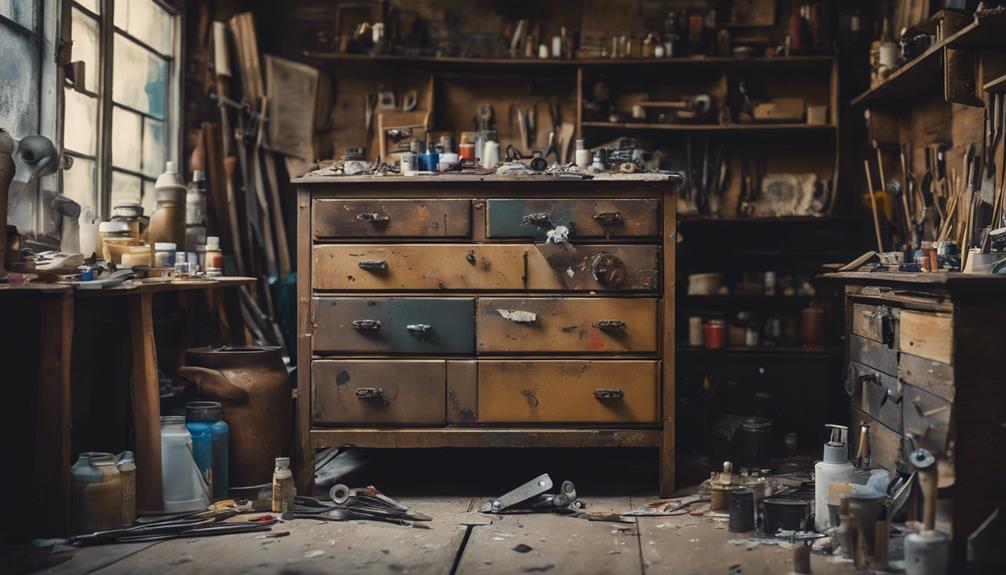
With over 12 million pieces of furniture discarded in the US every year, repurposing an old dresser can be a creative and environmentally friendly way to give new life to a discarded piece. You can transform it into a functional and stylish tall dresser that meets your specific needs and tastes. Start by examining the dresser's construction, size, and design, then thoroughly clean and disassemble it. Sand and smooth the surfaces, and consider refinishing options like paint or stain. Next, think about storage solutions and organization ideas, like hidden shelves and customized drawer dividers. As you progress, you'll uncover even more creative ways to upcycle and repurpose old dresser parts, leading you to a unique and functional final product.
Key Takeaways
• Assess the dresser's construction, size, and design to determine its potential for a tall dresser conversion.
• Disassemble the dresser, inspecting each component for damage or wear, and labeling hardware and pieces for reassembly.
• Refinish the dresser using an orbital sander, working up in grit for a smooth finish, and choosing a paint or stain color that fits the desired aesthetic.
• Implement storage solutions, such as hidden shelves, drawer organizers, and customized shelves, to maximize vertical space and organization.
• Upcycle dresser parts, like hardware and legs, into new DIY projects, like jewelry holders or wall-mounted shelving units, to reduce waste and add creativity.
Assessing the Dresser's Potential
What reveals a dresser's worthiness for repurposing, and how can you identify its potential for a tall dresser transformation?
When evaluating the dresser's potential, you'll want to examine its construction, size, and design. Look for solid construction, hardwood, and functional drawers to determine if it's a good candidate for repurposing. Consider the dresser's size and shape to envision how it can be converted into a tall dresser. Take measurements of the dresser's dimensions to plan for any modifications or additions required for the transformation.
When appraising the dresser's potential, you should also scrutinize the existing finish, hardware, and overall condition. Consider any damage, missing parts, or structural issues that may impact the dresser's suitability for repurposing.
With repurposed dresser ideas, it's important to be realistic about the extent of refurbishment needed. By evaluating the dresser's condition, you can determine the level of work required to achieve your desired outcome.
Cleaning and Disassembling
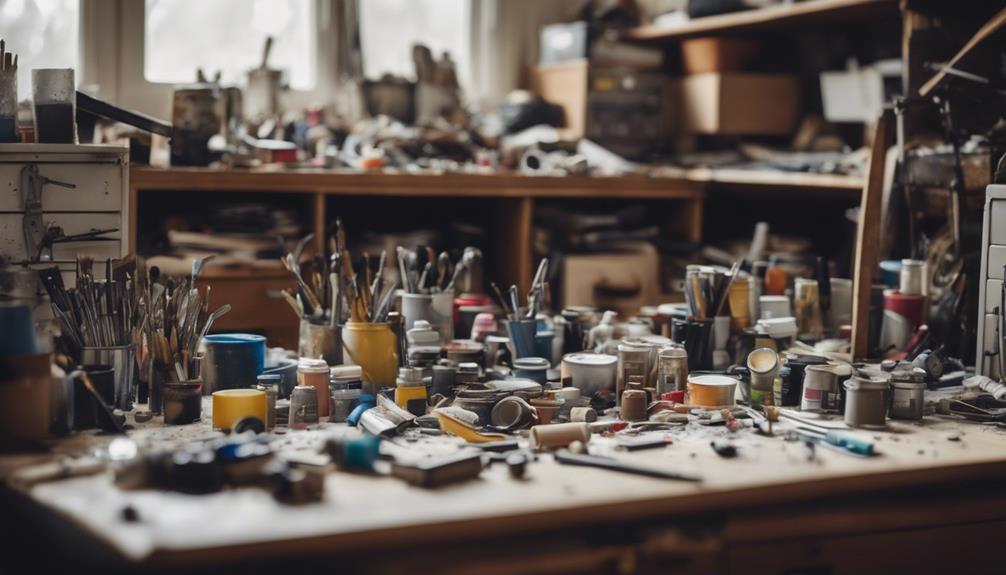
You'll want to start by giving the old dresser a thorough cleaning to remove the layers of dust, dirt, and grime that have built up over time. This cleaning process is important in preparing the dresser for its transformation. Use a gentle cleaner and a soft cloth to wipe down the entire dresser, paying close attention to any intricate carvings or details.
Once the dresser is clean, it's time to start disassembling it. Carefully remove the drawers, knobs, and any other detachable parts. As you disassemble, inspect each component for damage or wear that may need repair or replacement. Be sure to label or organize the hardware and pieces in a way that makes sense to you, so reassembly will be a breeze.
Take photos or notes of the original configuration to aid in putting the dresser back together. By taking the time to carefully clean and disassemble your old dresser, you'll be able to assess its condition and plan your transformation strategy.
Sanding and Smoothening Surfaces
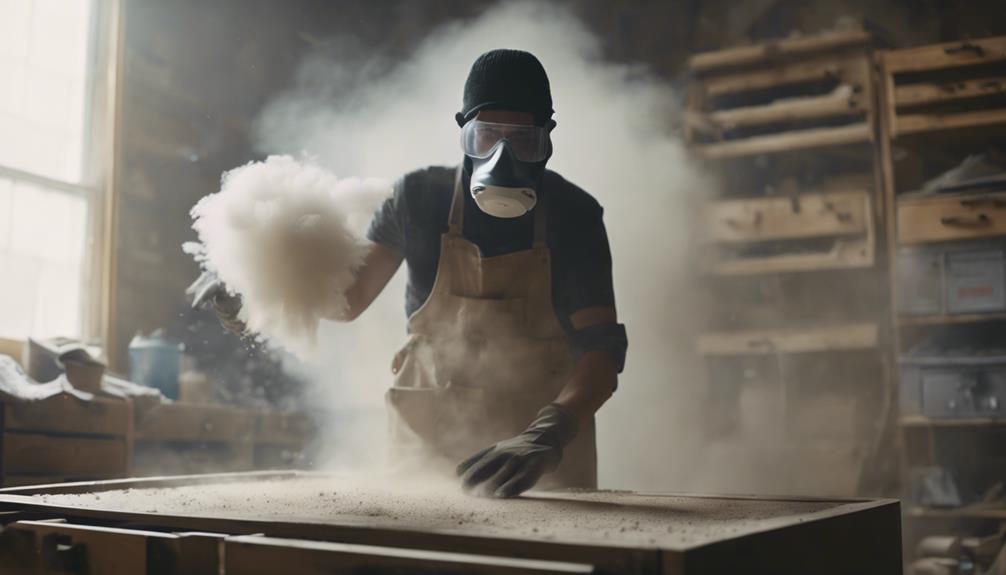
With the dresser disassembled and cleaned, you're ready to tackle the surfaces, removing imperfections and old finish with a thorough sanding process. Sanding is vital for achieving a smooth, even surface for your dresser makeover. It's important to remove any rough areas, old finish, and imperfections that may be present on the surface.
Here are some key points to keep in mind when sanding your dresser:
- Use an orbital sander: This will help you achieve a smooth finish and make the process much faster.
- Focus on corners and edges: Pay special attention to these areas, as they tend to be rougher than the rest of the surface.
- Work your way up in grit: Start with a coarse grit sandpaper and gradually move to finer grits for a smoother finish.
Proper sanding will guarantee better paint adhesion and a professional-looking final result. It's also a necessary step in preparing your dresser for further refinishing steps in the makeover process.
Painting and Staining Options
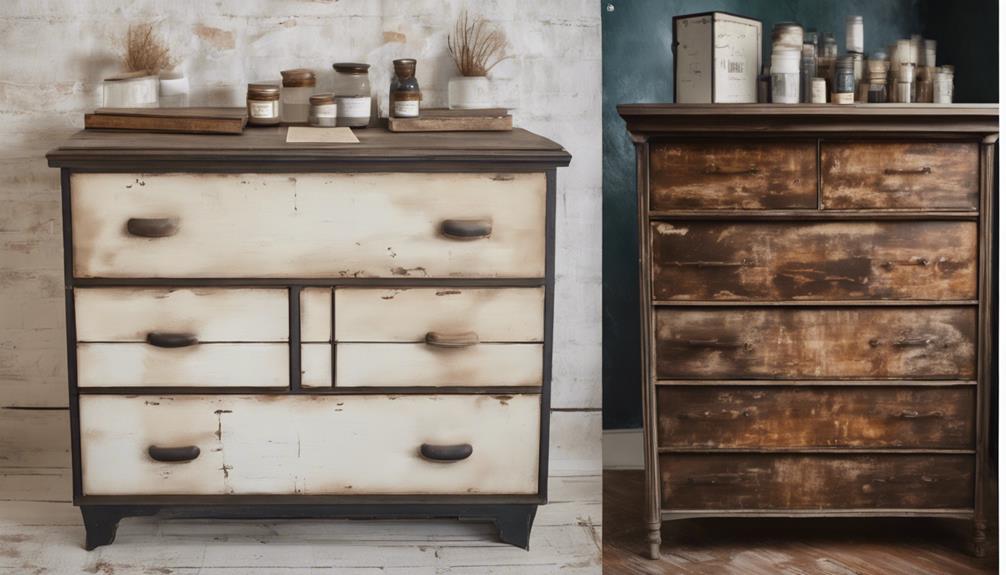
As you move on to the next stage of your dresser transformation, you're faced with an important decision: what kind of paint finish or stain color will you choose?
You'll need to contemplate the overall aesthetic you're aiming for, whether it's a bold, eye-catching hue or a more subtle, natural tone.
From matte to glossy, and from rustic to refined, the options are endless, and it's vital to weigh your choices carefully to achieve the desired look.
Paint Finish Options
Transforming your tall dresser into a unique piece requires selecting the perfect paint finish, and fortunately, you have several options to achieve the desired look. You can opt for a matte finish with a vintage vibe using Chalk Mineral paint, perfect for a distressed or shabby chic style.
Alternatively, you can choose Milk paint for a more authentic aged look with natural variations in color and texture. If you want to add depth and richness to your wood, consider using Gel stain, which enhances the natural grain while providing a deep color.
Here are three paint finish options to explore:
- Chalk paint: Achieve a matte finish with a vintage look.
- Milk paint: Get an authentic aged look with natural variations in color and texture.
- Gel stain: Add depth and richness to your wood with a deep color that enhances the natural grain.
Remember to top off your chosen paint finish with a durable, glossy coat of polyurethane to protect the wood and enhance the color. With these options, you can create a one-of-a-kind piece that reflects your personal style.
Stain Color Choices
You have five stain color options to contemplate for your repurposed tall dresser, each offering a unique aesthetic to match your personal style. Consider the classic and elegant look of a dark walnut color, which adds sophistication to any room. Alternatively, you can opt for a weathered gray stain to give your tall dresser a rustic and vintage feel.
Here's a breakdown of your stain color choices:
| Stain Color | Description |
|---|---|
| Dark Walnut | Classic and elegant, adds sophistication |
| Weathered Gray | Rustic and vintage, adds character |
| Rich Mahogany | Luxurious and timeless, adds elegance |
| Light Oak | Bright and modern, adds freshness |
| Custom Mixed | Unique and personalized, adds individuality |
Choose a rich mahogany stain for a luxurious and timeless appearance on your repurposed tall dresser. If you want to brighten up your tall dresser, go for a light oak stain for a modern and fresh look. Or, experiment with a custom mixed stain color to achieve a unique and personalized finish on your repurposed tall dresser.
Adding Decorative Hardware
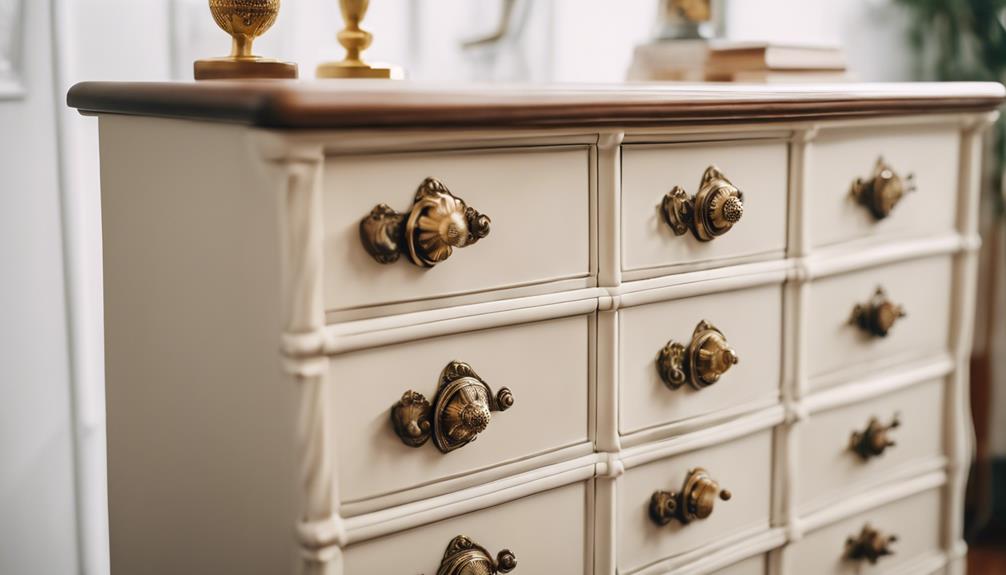
With a vast array of styles and finishes available, selecting the perfect decorative hardware for your repurposed tall dresser can be a pivotal step in elevating its overall aesthetic appeal. When updating hardware, consider the style and color of your dresser to guarantee a cohesive look. You'll also want to think about the functionality of the hardware in relation to the dresser's use.
For instance, if you're converting the dresser into a kitchen island, you may want hardware that's easy to clean and resistant to moisture.
Here are a few tips to keep in mind when selecting decorative hardware:
- Match the hardware to the dresser's style: Modern, vintage, or rustic – choose hardware that complements the dresser's aesthetic.
- Consider the finish: Brushed nickel, brass, or bronze – select a finish that complements the dresser's hardware and overall look.
- Think about functionality: Will the hardware be used frequently, or is it primarily for decorative purposes?
Creative Storage Solutions
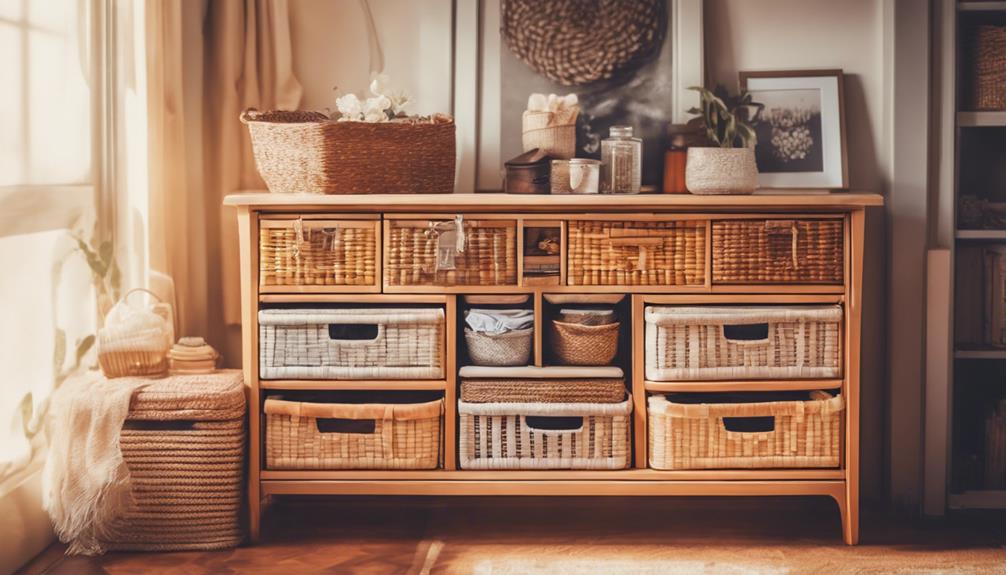
As you explore creative storage solutions for your repurposed tall dresser, you'll want to ponder innovative ways to maximize its capacity.
You can create hidden shelf spaces, implement clever drawer organizer ideas, and incorporate storage bins and baskets to keep your belongings organized and within reach.
Hidden Shelf Spaces
By incorporating hidden shelf spaces into your repurposed tall dresser, you'll reveal a wealth of creative storage solutions that maximize vertical space and keep clutter at bay. This clever design element not only adds functionality to your dresser but also elevates its style quotient.
With hidden shelves, you can store items like linens, clothes, or accessories, keeping them out of sight yet easily accessible.
Here are three benefits of incorporating hidden shelf spaces in your repurposed tall dresser:
- Maximizes vertical space: Hidden shelves make the most of your dresser's vertical space, allowing you to store more items without taking up extra floor space.
- Keeps clutter at bay: By storing items out of sight, hidden shelves help maintain a clutter-free space that's both visually appealing and easy to navigate.
- Adds functionality and style: Hidden shelves add a touch of sophistication to your dresser while providing additional storage, making it a practical and stylish addition to any room.
Drawer Organizer Ideas
You can create a clutter-free haven by implementing clever drawer organizer ideas that transform your repurposed tall dresser into a haven of creative storage solutions.
To maximize your drawer space, consider utilizing drawer dividers and inserts to separate items and keep them organized. You can also add a pop of color by using fabric or paper liners to protect the drawer bottoms.
For smaller items, use small containers or baskets within the drawers to keep them neatly stored. Another great idea is to use drawer organizers with adjustable compartments to customize your storage solutions.
If you want to make the most of your vertical space, consider using stackable organizers or drawer organizers with multiple tiers. By implementing these drawer organizer ideas, you'll be able to find what you need quickly and easily, and your repurposed tall dresser will become a model of efficiency and style.
With a little creativity and some clever storage solutions, you can turn your dresser into a clutter-free oasis.
Storage Bins and Baskets
Maximize the storage capacity of your repurposed tall dresser by incorporating storage bins and baskets that fit snugly inside the drawers, allowing you to categorize and retrieve items with ease. This creative storage solution will help you maintain organization and keep clutter at bay.
To get the most out of your storage bins and baskets, follow these tips:
- Choose the right size: Select bins and baskets that fit the dimensions of your dresser drawers to guarantee efficient organization.
- Label and categorize: Use clear or labeled bins to easily identify and access stored items, and categorize them by type or frequency of use.
- Add handles for ease: Incorporate baskets with handles for easy removal and transport of items, making it simpler to move them around or take them out of the dresser.
Repurposing Drawers and Shelves
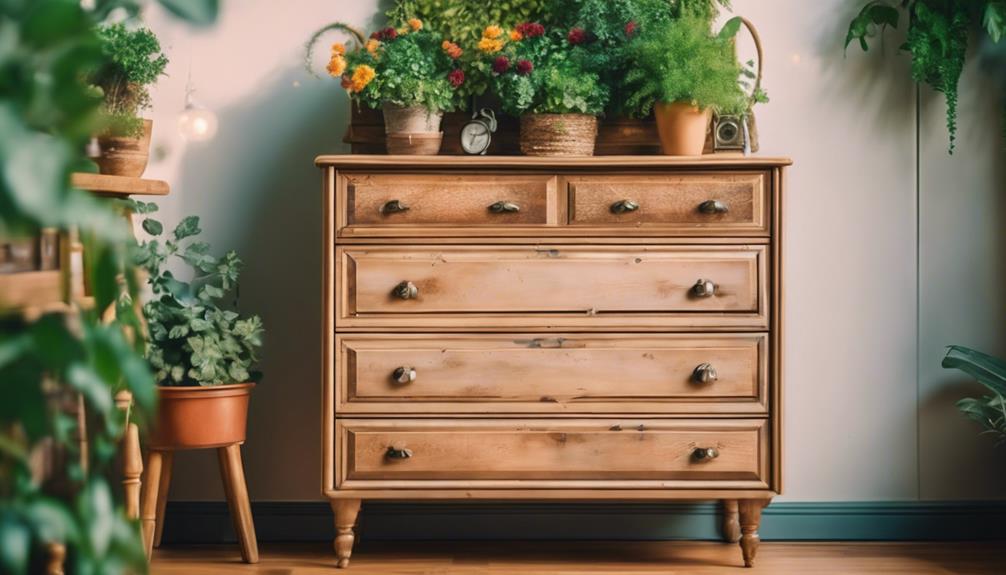
Converting a tall dresser's drawers and shelves into versatile storage solutions can open up a world of possibilities for organizing and decorating your space. You can repurpose drawers and shelves to create a functional piece of furniture that suits your specific needs.
For instance, removing drawers and adding shelves can help maximize vertical space in a room, making it perfect for storing items like books, linens, or kitchenware. Repurposed drawers can be used as open shelving for displaying decor or organizing items like clothes, toys, or office supplies.
Additionally, adding shelves to a tall dresser can transform it into a functional piece of furniture for different rooms in the home, such as a storage unit for a home office or a linen closet for a bedroom. The best part is that repurposing drawers and shelves in a tall dresser allows for customization based on individual storage needs and preferences.
Upcycling Old Dresser Parts
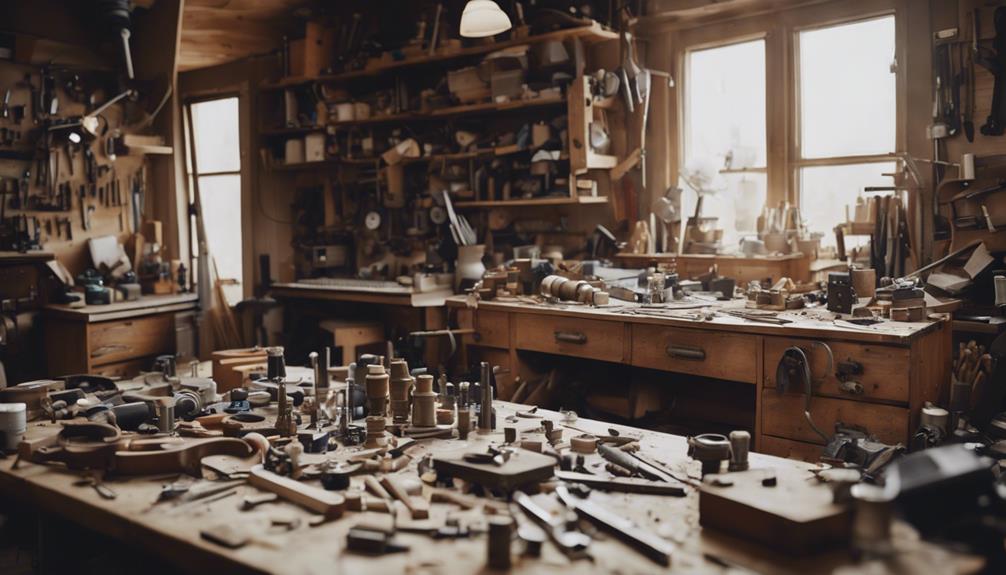
By repurposing the often-overlooked components of a tall dresser, you can breathe new life into old parts and tap into a world of creative possibilities.
As you're upcycling your dresser, don't forget to salvage its hardware, like knobs and handles, which can be reused in other DIY projects or replaced with new ones to enhance the overall look of the piece.
Here are some creative ways to upcycle old dresser parts:
- Transform dresser legs into furniture feet for new projects, adding character and style to different pieces.
- Reuse dresser hardware, such as handles and pulls, for DIY projects like jewelry holders or hanging decor, giving them a new purpose and aesthetic appeal.
- Upcycle dresser frames into wall-mounted shelving units, maximizing vertical storage in small spaces.
Adding Functional Features
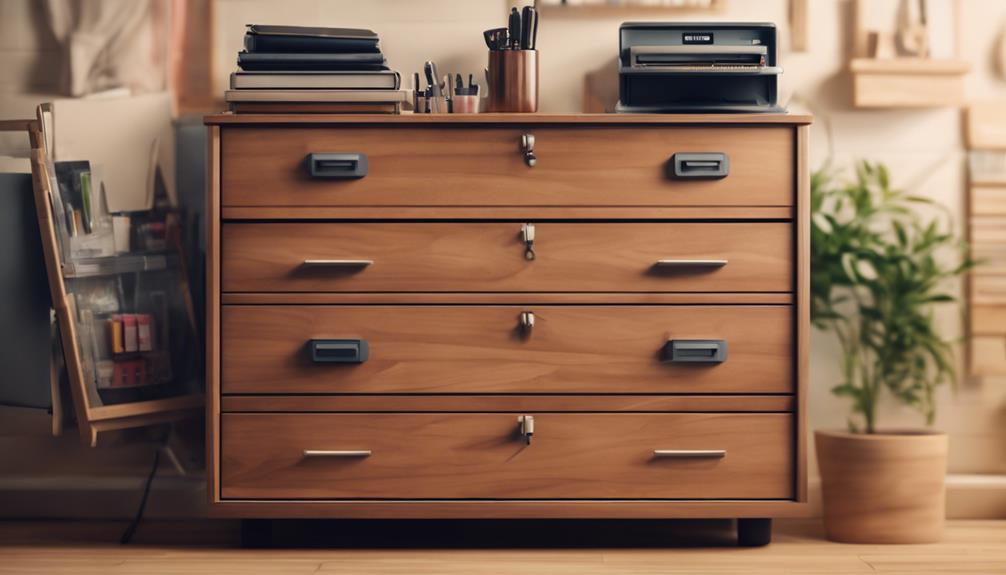
When repurposing your tall dresser, you'll want to contemplate adding functional features that enhance its storage capacity and usability.
You can start by incorporating storage drawer dividers to keep your belongings organized, and then think about customized shelf options that cater to your specific needs.
Storage Drawer Dividers
You can effortlessly create a more organized and functional dresser by incorporating storage drawer dividers, which are an excellent way to add a functional feature to your repurposed tall dresser. By installing drawer dividers, you can efficiently organize small items like socks, underwear, and accessories in your dresser drawers. This will prevent items from getting mixed up and make it easier to find what you need quickly.
Here are three benefits of using drawer dividers:
- Maximize storage space: Drawer dividers help keep your dresser drawers organized, making the most of the available storage space.
- Customization options: Drawer dividers come in various materials like plastic, bamboo, or fabric, offering customization options for different drawer sizes.
- Easy installation: Installing drawer dividers is a simple DIY project that can be completed in minutes with no special tools required.
Customized Shelf Options
Your repurposed tall dresser's functionality can be greatly enhanced with customized shelf options that cater to your specific storage needs. By incorporating adjustable shelves, you can accommodate different storage needs, ensuring that your dresser remains functional and efficient.
To maximize vertical space, consider installing tall shelves that can store items like books, baskets, or decor pieces. You can also customize shelf heights to fit specific items, making the most of your available storage capacity.
To take your storage solution to the next level, consider incorporating pull-out shelves for easy access to items stored in the dresser. Alternatively, you can install sliding or foldable shelves to create a versatile and functional storage solution. By doing so, you'll be able to store more items while maintaining a clutter-free space.
With customized shelf options, you can transform your repurposed tall dresser into a highly functional and organized storage unit that meets your unique needs.
Final Touches and Display
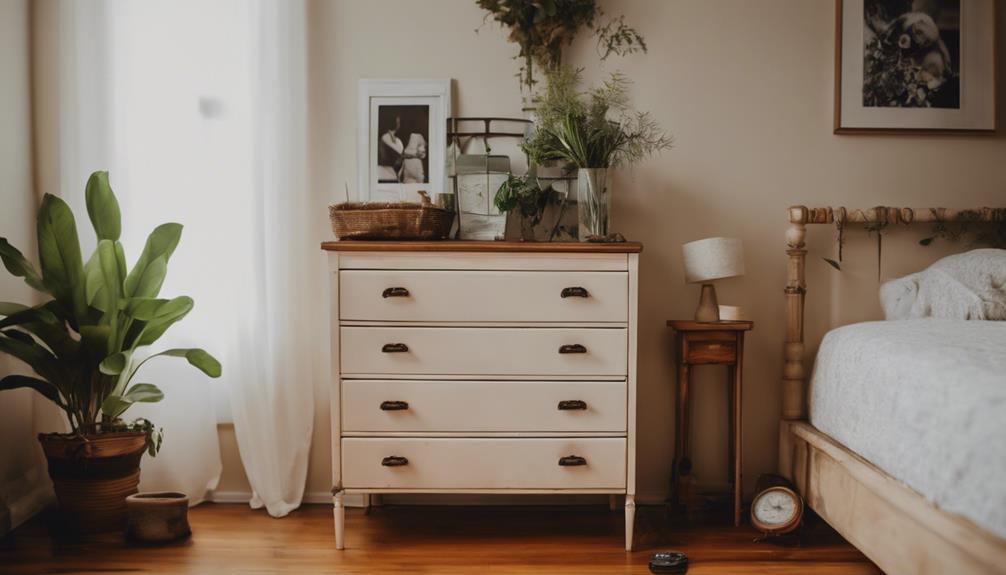
With the repurposed dresser's structural transformation complete, it's time to focus on adding those finishing touches that elevate its style and functionality. You've successfully transformed your old dresser into a new, functional piece of furniture, and now it's time to add the final flourishes.
To take your dresser to the next level, consider the following:
- Add decorative knobs or handles to give your dresser a personalized touch and enhance its overall aesthetic.
- Utilize the top surface for displaying personal items, decorative pieces, or even plants to create a visually appealing display.
- Use baskets or bins on the shelves for organized storage solutions that keep your belongings tidy and within reach.
Frequently Asked Questions
What Can I Do With a Tall Dresser?
You're wondering what to do with a tall dresser? Well, the possibilities are endless! You can repurpose it into a bookshelf, entertainment center, linen cabinet, craft storage unit, or even a chic plant stand.
Get creative and think beyond its original purpose. With a little imagination and some DIY skills, you can breathe new life into that old dresser and give it a fresh, functional purpose that suits your style and needs.
How Do You Revamp an Old Dresser?
As you begin the journey of revamping an old dresser, imagine breathing new life into a worn, tired piece of furniture.
You'll start by cleaning and repairing any damage, followed by a thorough sanding to smooth out the surface.
Next, apply a fresh coat of paint or stain to give it a vibrant makeover.
Don't forget to update the hardware for a modern twist, and feel free to experiment with creative techniques like distressing or stenciling to add unique flair.
How Can I Make My Old Dresser Taller?
To make your old dresser taller, there are several options you can consider. One option is to add legs or a base to the dresser. Another option is using risers or furniture lifts to elevate the height of the dresser. Alternatively, you could repurpose old furniture pieces such as table legs or bedposts to increase the height of the dresser.
Another approach is to choose a taller dresser design when shopping for new furniture. Additionally, you can enhance the visual height of the dresser by adding decorative elements like crown molding or trim. By implementing one or more of these strategies, you'll be able to achieve the taller dresser you're looking for.
How Do You Paint a Tall Dresser?
'Break a leg' with your painting project!
To paint a tall dresser, start by giving it a thorough cleaning to remove dirt or debris.
Next, choose a high-quality paintbrush or roller and select a paint type, such as chalk or latex, depending on your desired finish.
Apply coats evenly, allowing each to dry completely before adding the next.
Finish with a clear sealant or topcoat to protect the paint and enhance its longevity.
Conclusion
As you stand back to admire your transformed dresser, remember that its rebirth is a reflection of your own creative potential.
Just as you've breathed new life into this once-forgotten piece, you too can revitalize your own unique talents and skills.
The dresser's makeover serves as a metaphor for personal growth, reminding us that with a little imagination and elbow grease, we can transform ourselves into something truly remarkable.
Vivienne – Your Content Companion Vivienne is your content companion, curating valuable tips, advice, and inspiration to guide you on your home decor journey. From insightful blog posts to informative product descriptions, she’s here to empower you with the knowledge you need to create your dream space.
Home Decor
No, Your Scandinavian Kitchen Doesn't Have to Be All White
Transform your Scandinavian kitchen with vibrant colors and textures that defy the all-white norm—discover how to make it truly yours!
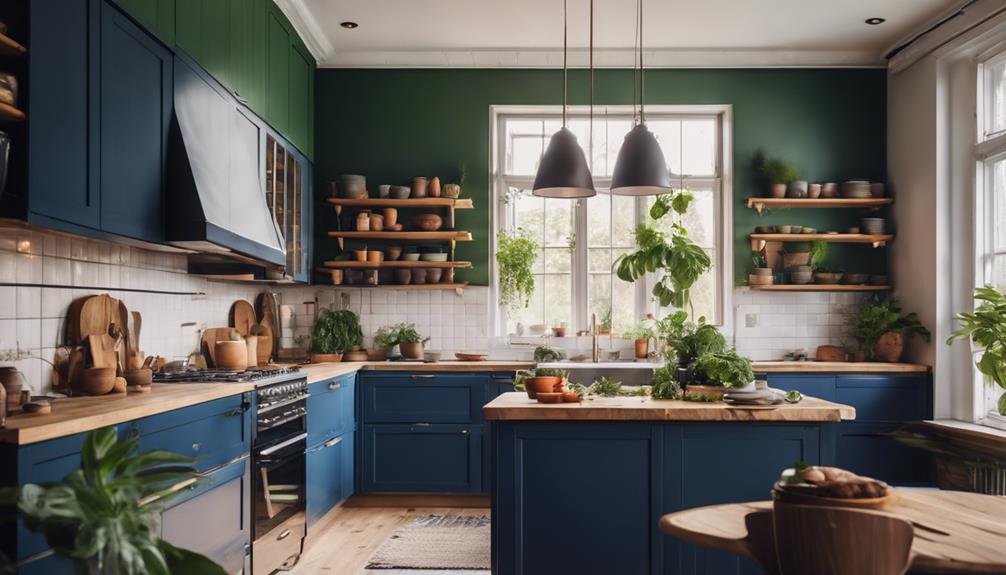
No, your Scandinavian kitchen doesn't have to be all white. You can embrace soft pastels, muted tones, and even bold accents to create a vibrant space. Think about colorful cabinetry paired with natural materials like wood and stone for warmth and texture. Light fixtures can act as eye-catching focal points while layered textiles add depth and personality. And don't forget about flooring options such as engineered hardwood or cork. It's all about mixing colors and textures to make your kitchen uniquely yours. Stick around, and you'll uncover more ideas on how to transform your space.
Key Elements
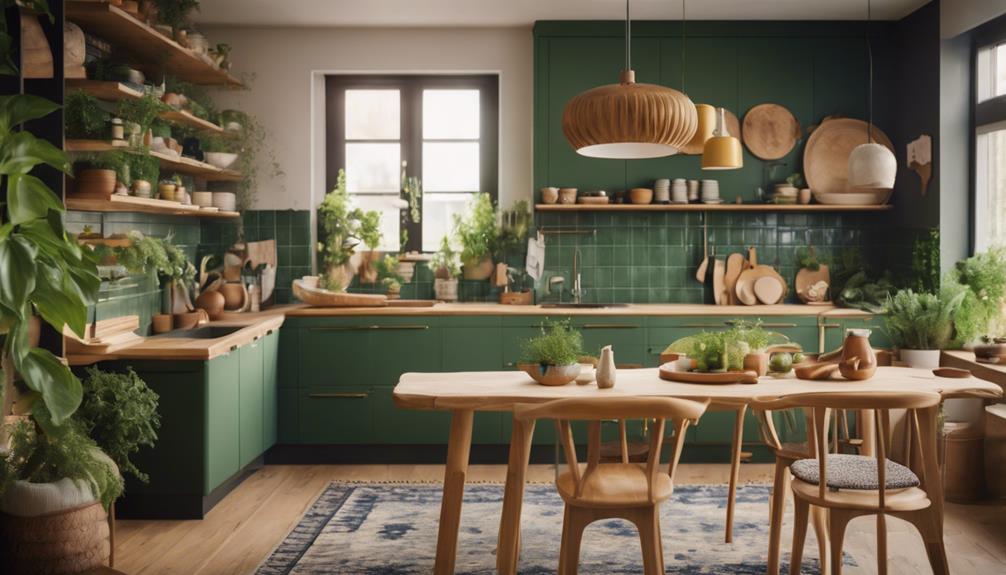
When you think about Scandinavian kitchen design, the key elements like color scheme, materials, and textures come into play.
You'll find that soft pastels and natural materials create a warm and inviting space.
Mixing textures adds depth, making your kitchen feel both functional and stylish.
Color Scheme
A vibrant color scheme in Scandinavian kitchen design goes beyond traditional whites, incorporating soft pastels, muted tones, and bold accents to infuse warmth and personality into the space. Embracing Scandi style means you don't have to settle for a sterile look; you can play with colors that reflect your taste.
Consider white walls as your canvas, allowing colorful cabinetry and accessories to pop. Soft blues, gentle greens, and warm yellows can create a welcoming atmosphere, while bold colors can serve as eye-catching focal points. This mix enhances visual interest without sacrificing the clean lines that define Scandinavian aesthetics.
Don't shy away from mixing textures and patterns either—this adds depth to your kitchen while maintaining a minimalist appeal. By strategically placing accent colors, you can create a balance between comfort and simplicity, ensuring your kitchen feels inviting yet organized.
The use of natural materials like wood and stone complements these colorful elements, reflecting your personal style while staying true to the functional ethos of Scandi design. So go ahead and experiment; your Scandinavian kitchen can truly be a vibrant expression of who you are.
Materials
Scandinavian kitchen design thrives on a mix of materials like natural wood, stone, and concrete, enhancing warmth and texture while maintaining simplicity. While white cabinetry remains popular, incorporating bleached wood accents can create a balanced aesthetic that adds depth without overwhelming the space. This combination keeps the design true to Scandinavian principles while introducing a touch of color.
Durable materials are also essential in this style. Quartz countertops and recycled components are increasingly favored, allowing you to promote sustainability without sacrificing elegance. Using stone or concrete elements can ground the design, providing a sturdy, earthy contrast to the often light and airy feel of white surfaces.
Don't shy away from integrating textured elements, like patterned tiles or metal fixtures, as they can add visual interest and break up the monotony of a mainly white palette. Accessories, furniture, and decor in vibrant colors can further infuse your kitchen with personality, moving beyond the all-white norm.
Textures
Incorporating a variety of textures, from soft textiles to sleek metals, adds depth and warmth to your Scandinavian kitchen, steering clear of a stark all-white aesthetic. Mixing materials, such as concrete tiles with wooden cabinetry, creates visual interest and aligns with contemporary Scandinavian trends. You can enhance this balance by introducing textured elements like woven baskets and ceramic dishes, which not only serve as functional decor but also contribute to the cozy, lived-in atmosphere typical of Scandinavian homes.
Layering different textures is key; imagine a plush rug underfoot paired with smooth countertops, promoting a tactile experience that invites engagement. This thoughtful approach encourages comfort and makes your kitchen feel more welcoming.
Additionally, consider using contrasting finishes, such as matte versus glossy surfaces. This interplay can highlight architectural features and prevent your kitchen from feeling monotonous.
Essential Fixtures and Furniture
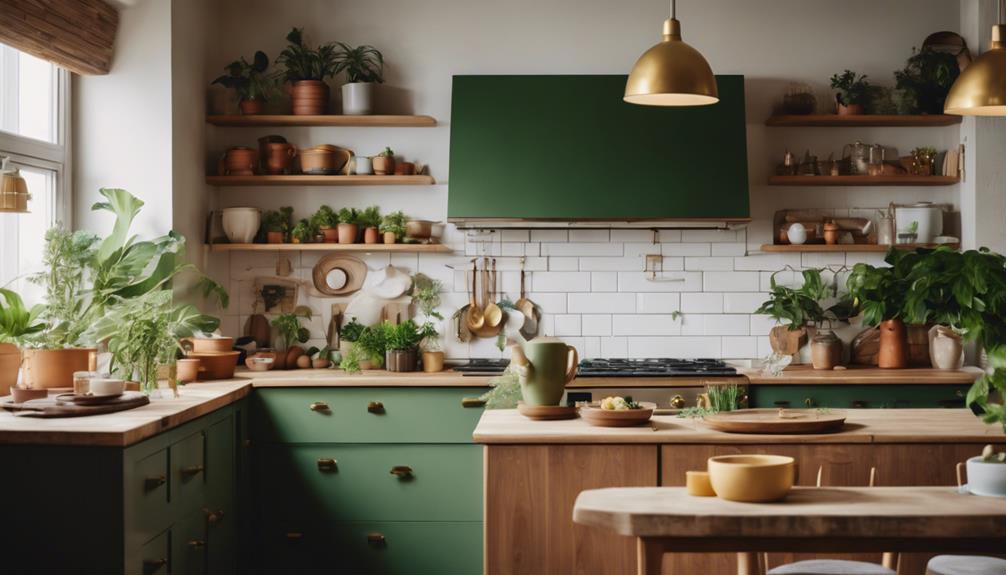
When designing your Scandinavian kitchen, choosing essential fixtures and furniture is vital for achieving that signature look.
A sleek Scandinavian sink paired with a minimalist pull-down faucet not only enhances functionality but also aligns with your aesthetic.
Don't forget to incorporate stylish pendant lighting to create an inviting atmosphere while illuminating your workspace.
Sleek Scandinavian Sink Design
A sleek sink design in your kitchen can elevate both functionality and style, embodying the essence of Scandinavian aesthetics. Scandinavian design often prioritizes clean lines and minimalistic forms, guaranteeing your sink seamlessly integrates into modern kitchen layouts. Opting for durable materials like stainless steel or composite not only enhances the sleek appearance but also assures longevity.
Consider an under-mount sink, a popular choice that creates a streamlined look and simplifies cleaning compared to traditional drop-in models. In Scandinavian kitchens, large, deep sinks are common, allowing you to handle both cooking and cleaning tasks with ease. Pairing these sinks with high-arc faucets adds further functionality while maintaining the minimalist vibe.
Don't forget about accessories! Cutting boards and colanders designed to fit over your sink can maximize workspace without compromising the clean aesthetic central to Scandinavian design. This thoughtful approach to sink selection guarantees that your kitchen remains not only stylish but also practical for daily use.
Minimalist Pull-Down Faucet
The sleek design of a minimalist pull-down faucet perfectly complements the streamlined aesthetics of Scandinavian kitchens, enhancing both functionality and style.
When you choose a faucet with a clean, modern silhouette, you're elevating the overall Scandi look while ensuring practicality in your space. These fixtures usually come in durable materials like stainless steel or matte black finishes, adding a contemporary touch that pairs well with your design scheme.
The pull-down feature is a game changer, allowing you to easily maneuver the faucet for various kitchen tasks.
Whether you're rinsing dishes or filling large pots, you'll find the increased reach incredibly convenient. Plus, many of these faucets utilize a single-handle design, promoting simplicity and ease of use, which is essential for maintaining a clutter-free countertop.
Scandinavian-Style Pendant Light
Scandinavian-style pendant lights enhance your kitchen's aesthetic with their clean lines and minimalist designs, ensuring both beauty and functionality. These essential fixtures often feature natural materials like wood and metal, reflecting the Scandi emphasis on simplicity and practicality in kitchen design.
You'll find that statement lighting—like oversized or uniquely shaped pendant lights—can act as enchanting focal points, adding character and warmth to your space. Placing pendant lights above kitchen islands or dining areas is a common practice in Scandinavian design, fostering social interaction and creating a cozy atmosphere that invites gatherings.
When selecting pendant lights, consider brands like Muuto and Gubi, which offer a range of options that blend contemporary design with traditional Nordic elements. This approach allows you to cater to diverse style preferences while maintaining the minimalist essence of Scandi design.
Lighting Ideas
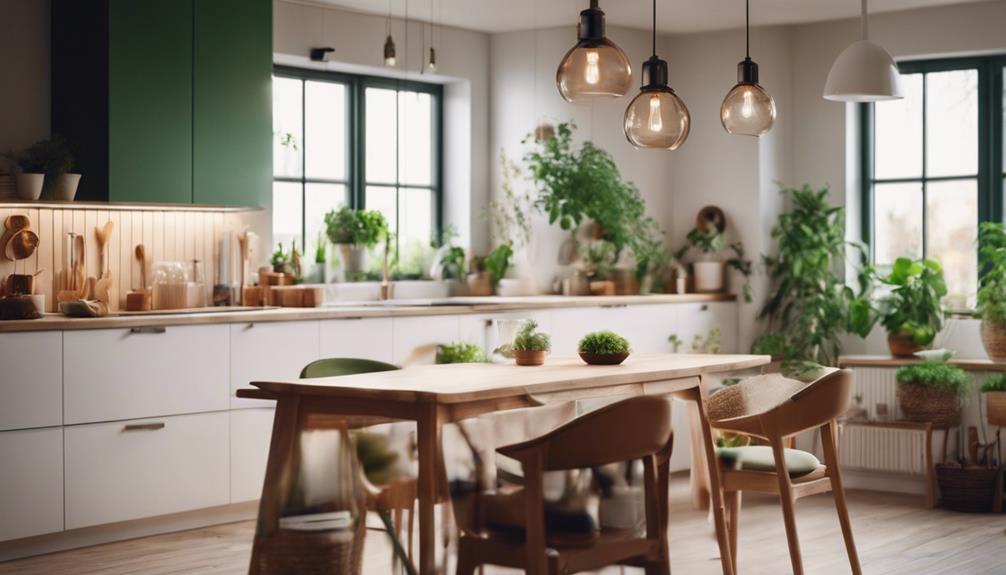
When it comes to lighting in your Scandinavian kitchen, you can transform the space with a mix of warm LED under-cabinet lights and statement pieces featuring geometric shapes.
Maximizing natural light through large windows and mirrors not only brightens the room but also enhances its airy feel.
Additionally, consider recessed ceiling spotlights for a sleek look that complements the overall design while providing functional illumination.
Warm LED Under-Cabinet Lighting
Enhancing your kitchen's ambiance with warm LED under-cabinet lighting not only creates a cozy atmosphere but also highlights the beauty of your cabinetry and countertops. This lighting solution is perfect for Scandinavian kitchens, as it adds warmth to wood and colored cabinetry while softening the starkness often found in all-white designs.
Warm LED under-cabinet lighting is energy-efficient, consuming up to 75% less energy than traditional incandescent bulbs, making it a sustainable choice for eco-conscious homeowners. You can choose from various color temperatures, typically ranging from 2700K to 3000K, to complement the soft pastels and muted tones common in Scandinavian interiors.
Not only does this lighting improve visibility for meal preparation, but it also creates depth and dimension, effectively showcasing the textures and patterns of your cabinets and countertops. By strategically placing warm LED strips or fixtures, you can foster a cozy ambiance in the evenings, encouraging social interaction and relaxation in your kitchen space.
Natural Light Maximization Techniques
Maximizing natural light in your kitchen can transform the space into a bright and inviting area, perfectly aligned with the airy essence of Scandinavian design.
Start by incorporating large windows or glass doors, which not only invite abundant natural light but also create a seamless connection with the outdoors.
To further enhance the light, use reflective surfaces like glossy cabinets or metallic accents; these bounce light around the room, amplifying brightness. Opt for light-colored walls and countertops to improve light reflection, making your kitchen feel more spacious and open.
If your kitchen lacks wall space for windows, consider installing skylights or light tubes. These features allow natural light to flood in from above, illuminating the space beautifully.
Additionally, open shelving can help avoid visual clutter and permit light to flow freely. This not only showcases the beauty of your kitchen items but also emphasizes the natural light that pours in.
Recessed Ceiling Spotlights
Recessed ceiling spotlights perfectly complement the natural light strategies you've implemented, offering a sleek and minimalist lighting solution that enhances the Scandinavian kitchen aesthetic. These fixtures not only provide ample illumination but also blend seamlessly into your ceiling, maintaining the clean lines characteristic of Scandinavian design.
By strategically placing recessed ceiling spotlights, you can highlight key areas like countertops and dining spaces. This approach enhances both functionality and visual appeal, ensuring your kitchen feels both inviting and efficient. Plus, many of these lights are dimmable, allowing you to adjust the brightness for various moods and activities, making your kitchen versatile for cooking, entertaining, or relaxing.
If you're committed to sustainable living, consider using energy-efficient LED bulbs in your recessed ceiling spotlights. This choice not only reduces energy consumption but aligns perfectly with the eco-friendly practices often embraced in Scandinavian design.
Ultimately, recessed ceiling spotlights are an ideal lighting solution, enhancing your kitchen's simplicity and functionality while keeping it clutter-free. So, embrace this stylish option and elevate your Scandinavian kitchen to new heights.
Statement Lighting With Geometric Shapes
Statement lighting featuring geometric shapes transforms your Scandinavian kitchen into a modern aesthetic, adding both style and character. These unique fixtures, like pendant lights and chandeliers, act as stunning focal points, drawing attention and creating visual interest above your kitchen island or dining area.
Using materials such as metal, glass, or wood in your geometric lighting enhances the natural and functional appeal of Scandinavian decor, fostering a warm and inviting atmosphere. You can break the monotony of a chiefly white kitchen by incorporating bold colors or unique shapes in your statement lighting. This approach introduces personality and character without overwhelming the simplicity of the space.
Moreover, geometric lighting goes beyond mere functionality; it allows for creative expression that aligns with contemporary trends. By blending traditional Scandinavian simplicity with modern flair, you'll achieve a striking balance.
Whether you choose minimalist designs or more intricate shapes, statement lighting can elevate your kitchen's overall design, making it feel fresh and contemporary. Embrace these geometric lighting ideas, and watch your kitchen come alive with vibrant energy and style.
Decorative Elements

Incorporating decorative elements like a handwoven textile wall hanging or a ceramic vase filled with dried flowers can add personality to your Scandinavian kitchen.
A wooden bowl with natural accents not only serves a functional purpose but also enhances the warm, inviting feel of the space.
These touches create a balance between minimalism and individual expression, making your kitchen truly yours.
Handwoven Textile Wall Hanging
Handwoven textile wall hangings bring warmth and texture to Scandinavian kitchens, enhancing the minimalist design with their vibrant colors and unique patterns. These decorative elements often feature natural fibers like wool and cotton, aligning perfectly with the Scandinavian focus on sustainable materials.
By incorporating handwoven textile wall hangings, you can create striking focal points that break the monotony of the typical white and neutral tones. The bold colors and geometric designs of these textiles allow you to express your individual style while maintaining the cozy atmosphere that Scandinavian interiors are known for.
Whether you choose a large statement piece or a series of smaller hangings, each one adds character and depth to your kitchen. Moreover, the artisanal craftsmanship behind handwoven textile wall hangings often reflects local traditions, infusing your space with a sense of cultural heritage and authenticity.
This makes them not just decor but also a story of community and creativity. So, don't shy away from adding these eye-catching elements; they can transform your kitchen into a warm, inviting space that feels uniquely yours.
Ceramic Vase With Dried Flowers
How can a ceramic vase filled with dried flowers enhance the warmth and personality of your Scandinavian kitchen? This simple addition can break the monotony of an all-white aesthetic, bringing life and character into your space.
Dried flowers aren't only visually appealing but also low-maintenance, making them perfect for busy kitchens. They provide texture and interest, complementing the minimalist design typical of Scandinavian decor.
Choosing a ceramic vase in various shapes and colors allows you to express your style without overwhelming the kitchen. You'll find that these vases can evoke a sense of nature and hygge, essential elements that promote comfort and coziness.
Additionally, if you opt for locally sourced or artisanal ceramic vases, you'll be supporting sustainable practices that align with the eco-friendly values often found in Scandinavian design.
Wooden Bowl With Natural Accents
A wooden bowl filled with natural accents not only brings warmth to your Scandinavian kitchen but also enhances the space's minimalist charm. These bowls serve as both functional and decorative elements, making them perfect for food prep or serving. Imagine the kitchen sounds of fresh fruits being tossed into a beautifully crafted bowl, elevating your everyday tasks.
Incorporating sustainably sourced wood aligns with eco-friendly practices and adds a rustic touch that complements the overall design ethos. You can place a wooden bowl on your countertop or dining table, where it becomes a focal point, breaking up the monochromatic palette typical in Scandinavian design.
Pair your wooden bowl with other natural materials like stone or ceramic to create a layered texture that invites warmth and coziness into your kitchen. This thoughtful integration of decorative elements reflects the values of simplicity and functionality inherent in Scandinavian interiors.
Flooring
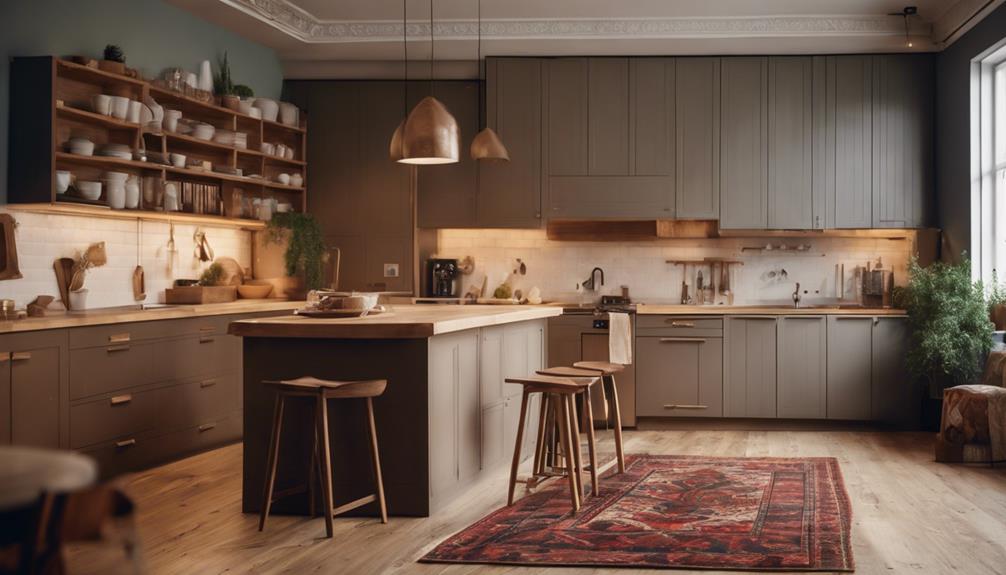
When choosing flooring for your Scandinavian kitchen, consider engineered hardwood with a light finish for a bright, warm feel.
If you want added comfort, cork flooring can bring warmth underfoot while maintaining a sleek look.
For a more modern touch, polished concrete offers durability and a clean aesthetic that fits perfectly in a minimalist design.
Engineered Hardwood With Light Finish
Engineered hardwood with a light finish creates an airy atmosphere in your kitchen, perfectly aligning with the essence of Scandinavian design. This flooring option enhances the spacious feel typical of Scandinavian interiors, making your kitchen bright and inviting.
Engineered hardwood floors combine a core of plywood or high-density fiberboard with a top layer of real wood, giving you the beauty of solid wood while ensuring durability and moisture resistance. You'll appreciate that light-finished engineered hardwood is less prone to showing scratches, dents, and wear, making it a practical choice for high-traffic areas like your kitchen.
With various wood species available, such as oak and maple, you can easily complement any color palette—from soft pastels to vibrant accents—within your Scandinavian design.
Installation is versatile, too; whether you prefer a floating, glue-down, or nail-down method, engineered hardwood fits into different kitchen layouts and preferences seamlessly.
Cork Flooring for Warmth
Cork flooring offers a warm, inviting touch to your Scandinavian kitchen, perfect for those chilly months. This eco-friendly option provides natural insulation, helping to keep your space cozy when temperatures drop. The unique cellular structure of cork flooring not only traps warmth but also absorbs sound, creating a quieter environment—ideal for family gatherings or cooking adventures.
Durability is another standout feature of cork flooring. It can withstand heavy foot traffic, making it resilient enough for your bustling kitchen. Plus, you'll appreciate the variety of colors and patterns available, allowing you to personalize your design while complementing the vibrant accents typically found in Scandinavian interiors.
Being a natural material, cork flooring is hypoallergenic and resistant to mold, which enhances your kitchen's indoor air quality. This means you can enjoy a healthier cooking and dining experience without compromising on style.
Polished Concrete for Durability
Polished concrete flooring stands out for its exceptional durability, making it an ideal choice for the high-traffic areas of your Scandinavian kitchen. This flooring option resists scratches and stains, ensuring it can withstand the hustle and bustle of everyday life without losing its appeal.
Plus, its ability to reflect light enhances the brightness of your space, seamlessly complementing the minimalist aesthetic that defines Scandinavian design.
You'll appreciate the low-maintenance aspect of polished concrete, as it requires only occasional cleaning and sealing to keep it looking fresh. With various finishes and colors available, you can easily customize your flooring to align with your vibrant or muted color schemes.
Additionally, polished concrete has thermal mass properties, which means it can help regulate indoor temperatures, contributing to energy efficiency in your home. This not only keeps your kitchen comfortable but also can lead to savings on energy bills.
If you're looking for a flooring option that combines style, durability, and practicality, polished concrete is definitely worth considering for your Scandinavian kitchen.
Conclusion
You don't have to stick to an all-white palette for your Scandinavian kitchen.
Embrace color and personality by incorporating vibrant fixtures, bold decorative elements, and unique flooring choices.
By mixing essential furniture with eye-catching accents, you'll create a warm and inviting space that reflects your style.
Remember, the heart of your kitchen should be a reflection of you, so let your creativity shine and enjoy the process of making the space truly yours!
Home Decor
Natural Elements in Home Decor – You Won’t Believe the Transformation!
Discover how incorporating natural elements can profoundly change your home decor, leaving you amazed by the transformation that awaits!
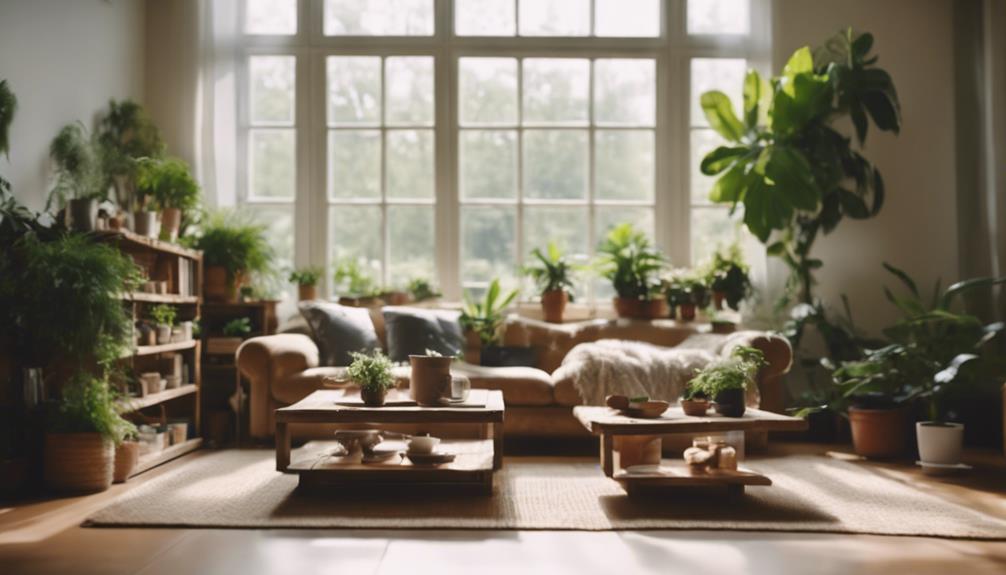
Bringing natural elements into your home decor can create a stunning transformation, both visually and emotionally. Think about adding indoor plants to purify the air and boost your mood. Incorporate earthy tones and textures to foster relaxation and warmth. Large windows can invite natural light, making your space feel more open and inviting. Simple touches like jute rugs or reclaimed wood can add unique character and connection to nature. Embracing these ideas not only enhances your home's beauty but also supports your well-being. There's a wealth of creative strategies to explore further, revealing even more inspiring transformations.
Key Takeaways
- Incorporating large windows floods spaces with natural light, significantly uplifting mood and reducing feelings of anger and sadness.
- Indoor plants not only filter pollutants but also enhance creativity and productivity, creating a healthier living environment.
- Using earthtone colors and organic materials fosters a calming atmosphere, promoting relaxation and overall well-being.
- Seasonal decor updates allow you to celebrate nature's beauty, evoking cherished memories and making spaces more inviting.
The Impact of Natural Elements
Incorporating natural elements into your home decor can elevate your mood and wellbeing, making your living space feel more inviting and peaceful.
When you embrace interior design that prioritizes natural light, you not only enhance the visual appeal of your home but also foster a healthier environment. Large windows that let in sunlight can improve your emotional state, reducing feelings of anger and sadness.
Adding indoor plants is another effective strategy. They filter pollutants from the air, promoting better air quality and, in turn, boosting your overall mood.
Choosing earthtone paint colors and using materials like wood and stone can create a calming atmosphere, encouraging relaxation and tranquility in your daily life.
Furthermore, a thoughtfully designed layout that highlights natural views and elements can strengthen your connection to the outdoors, enriching your living experience. This connection not only enhances your home's aesthetics but can even increase its property value.
Designing With Nature in Mind
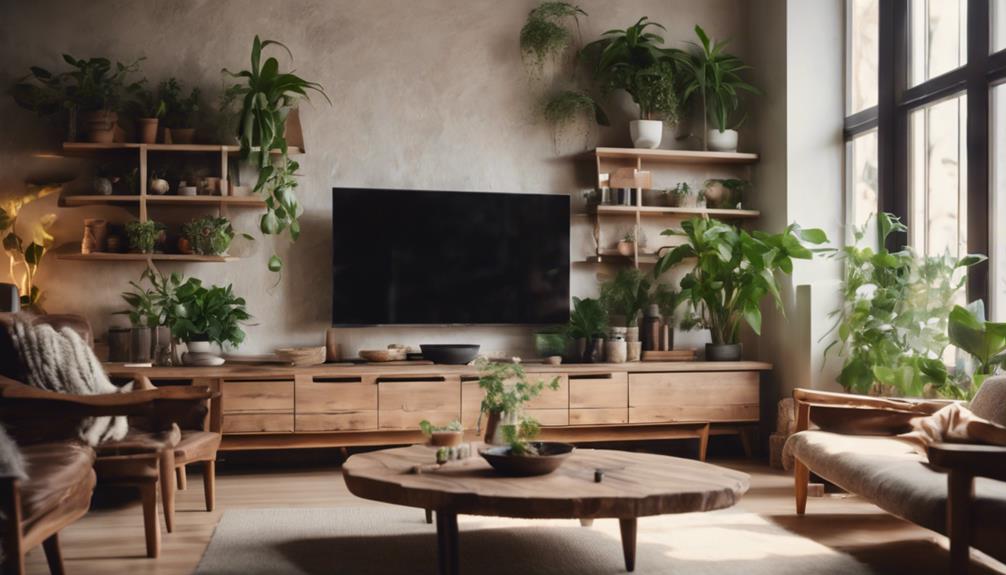
When you design with nature in mind, you embrace the benefits of natural decor that promotes well-being and tranquility.
You can draw inspiration from seasonal changes and select sustainable materials that not only look good but also support the environment.
Let's explore how these elements can transform your space into a harmonious retreat.
Benefits of Natural Decor
How can natural decor transform your living space into a sanctuary that boosts your emotional well-being? By incorporating natural home decor, you create a peace environment that fosters relaxation and reduces stress. The use of organic materials like wood and stone introduces unique natural textures that enhance warmth and comfort in your home.
Here's a quick overview of the benefits:
| Benefit | Description |
|---|---|
| Stress Reduction | Proximity to nature lowers stress levels. |
| Improved Air Quality | Plants filter pollutants, enhancing your space. |
| Enhanced Creativity | Natural elements inspire creativity and productivity. |
Designing with earthy tones and organic shapes not only beautifies your space but also nurtures a deeper connection to nature. This connection is linked to increased happiness and overall well-being. By bringing in these elements, you'll notice a transformation in your atmosphere, making it more inviting and vibrant. Embrace natural decor to uplift your spirits and create a sanctuary that reflects tranquility and harmony.
Seasonal Design Inspirations
Embrace the beauty of each season by infusing your home with decor that reflects nature's vibrant changes throughout the year. Seasonal design inspirations can transform your space, making it feel alive and connected to the environment.
For autumn, consider decorating your home with warm colors, using items like fallen leaves and pinecones to create a cozy atmosphere. In spring, fresh flowers bring a sense of renewal and joy, brightening your interior with their natural beauty.
Updating your decor seasonally not only celebrates the passing of time but also fosters a deeper connection to the natural world. You'll find that crafting with natural materials, such as wreaths made from moss or tree bark, adds an eco-friendly touch to your home.
This practice encourages creativity while enhancing emotional well-being, evoking cherished memories tied to each season.
Sustainable Material Choices
Choosing sustainable materials for your home decor not only enhances its beauty but also aligns your space with environmentally conscious practices. By making thoughtful decisions about your materials, you contribute to a healthier planet while creating a unique atmosphere in your home.
Feel the warmth of reclaimed wood, telling a story of its past.
Experience the comfort of natural fibers like jute and linen, wrapping your space in serenity.
Embrace eco-friendly materials with Environmental Product Declarations (EPDs), ensuring your choices meet sustainability criteria.
Enjoy the beauty of upcycled design, reducing waste and adding character to your decor.
Incorporating sustainable material choices, such as wood, stone, and clay, supports environmental conservation through responsible sourcing.
Prioritizing local sourcing reduces carbon footprints and fosters a connection to your community and ecosystem.
By choosing biodegradable and renewable textiles, you not only create a calming atmosphere but also contribute to reducing landfill waste.
Your decor can be a reflection of your values—choose wisely and transform your home into a haven that respects nature while showcasing your style.
Creative Ways to Bring Nature Indoors
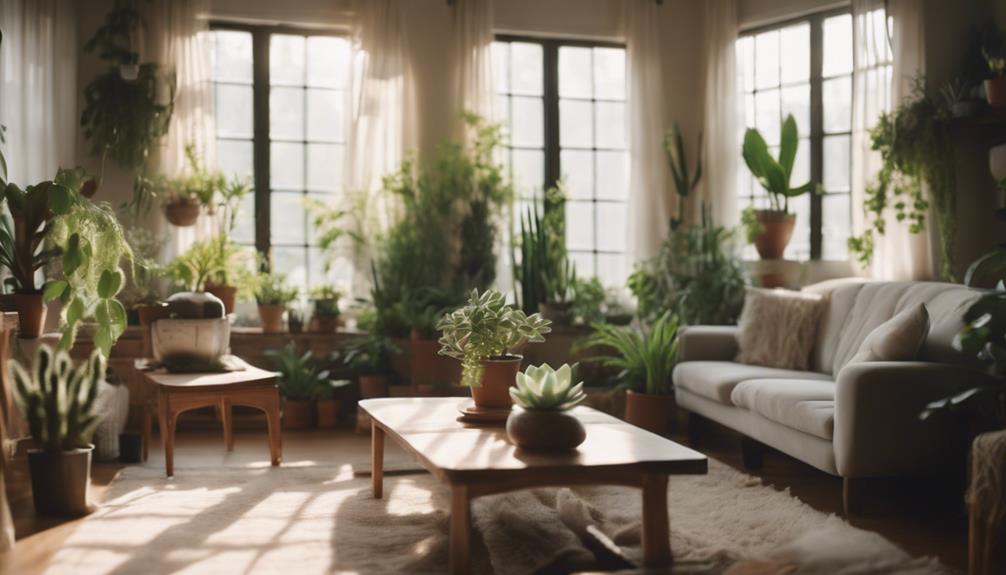
Bringing nature indoors can transform your space in exciting ways. You can use seasonal decor, incorporate indoor plants, and choose natural materials to create a fresh, inviting atmosphere.
Each element not only enhances your home's aesthetic but also boosts your well-being.
Seasonal Decor Ideas
Transform your home with seasonal decor that showcases the beauty of nature, making your space feel warm and inviting throughout the year.
By incorporating seasonal decor ideas, you can easily bring nature indoors and create a harmonious atmosphere that reflects each season's essence. Interior designers often recommend switching up your decor to keep it fresh and dynamic, allowing you to connect with the changing environment.
Here are some creative ways to evoke emotion through your seasonal decor:
- Autumn leaves scattered in a bowl or as a centerpiece for a cozy vibe.
- Fresh spring flowers arranged in vibrant vases to breathe life into your space.
- Pinecones and acorns used in wreaths or table displays to celebrate fall's charm.
Engaging in eco-friendly crafting with these natural elements not only enhances your decor but also promotes sustainability.
Indoor Plant Benefits
Indoor plants not only elevate your home's aesthetic but also offer a host of health benefits that can enhance your overall well-being. By filtering harmful pollutants like carbon monoxide and formaldehyde, these indoor plants greatly improve air quality, making your living space healthier. When you surround yourself with greenery, you can reduce your stress levels by up to 30%, creating a more peaceful environment that fosters relaxation and productivity.
Plants such as snake plants and peace lilies are particularly effective at removing toxins and thrive even in low-light conditions, making them perfect for any room. Adding greenery can also boost humidity levels, helping to prevent dry skin and respiratory issues. Plus, having indoor plants can enhance your creativity and focus by up to 15%, which is especially beneficial in workspaces or study areas.
Incorporating indoor plants into your decor not only beautifies your home but also cultivates a nurturing space that promotes well-being. So, why not bring the outdoors in and enjoy the transformative benefits of nature right at home?
Natural Material Textures
Natural materials like wood, stone, and clay create an inviting atmosphere that instantly connects your home to the beauty of the outdoors. By incorporating these elements, you can effortlessly add warmth and character to your space.
Here are some creative ways to integrate natural material textures into your decor:
- Reclaimed wood furniture: Each piece tells a story and brings a rustic charm.
- Natural stone accents: Use a stone coffee table or backsplash for a touch of elegance.
- Linen curtains: They soften light and evoke a sense of calm.
Layering various natural textures fosters a cohesive look while enhancing your home's overall aesthetic. For instance, pair a jute rug with wooden furniture and linen curtains to create a dynamic and inviting environment.
Sustainable sourcing of these materials not only benefits the planet but also guarantees that each item is unique. By bringing these natural elements indoors, you'll cultivate a tranquil space that resonates with comfort and connection to nature.
Embrace the beauty of natural material textures, and watch your home transform into a serene retreat.
Benefits of Open Concept Spaces
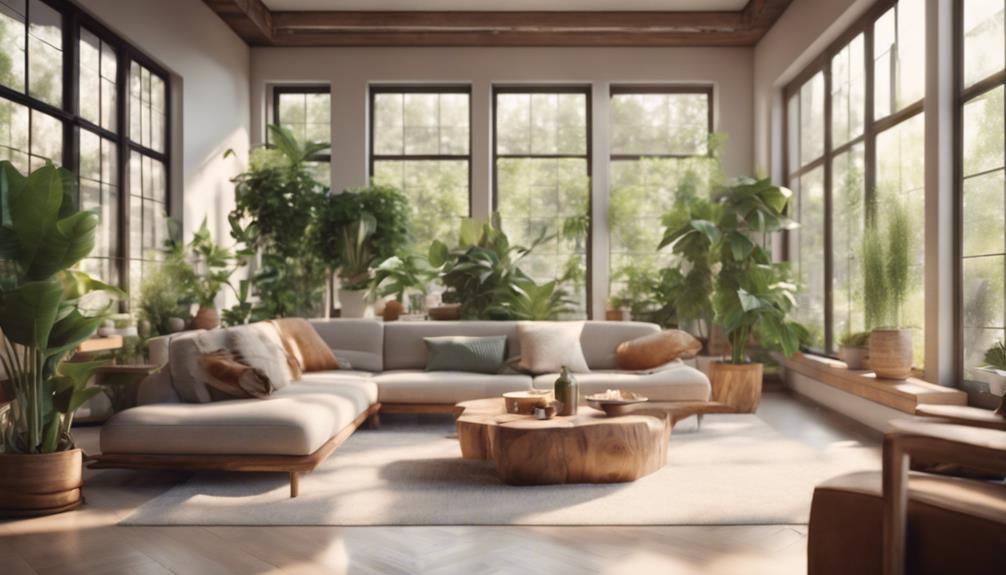
Open concept spaces invite more natural light into your home, creating a brighter atmosphere that boosts your mood and overall well-being. By removing non-load-bearing walls, these layouts enhance the flow of light and promote social interaction among family members, fostering a sense of community. You'll enjoy a seamless connection between your indoor and outdoor environments, maximizing landscape views and increasing your property value.
Living in an open concept design can also alleviate feelings of confinement, particularly in urban settings. The spaciousness of these areas creates a liberating living experience that feels more connected to the natural environment around you. Additionally, integrating natural elements like large windows or indoor plants enhances airflow, contributing to tranquility and emotional well-being.
In essence, open concept spaces not only brighten your home but also elevate your overall lifestyle. You're not just investing in a beautiful design; you're actively enhancing your quality of life by embracing a layout that encourages light, interaction, and a connection to nature.
Achieving Harmony in Decor
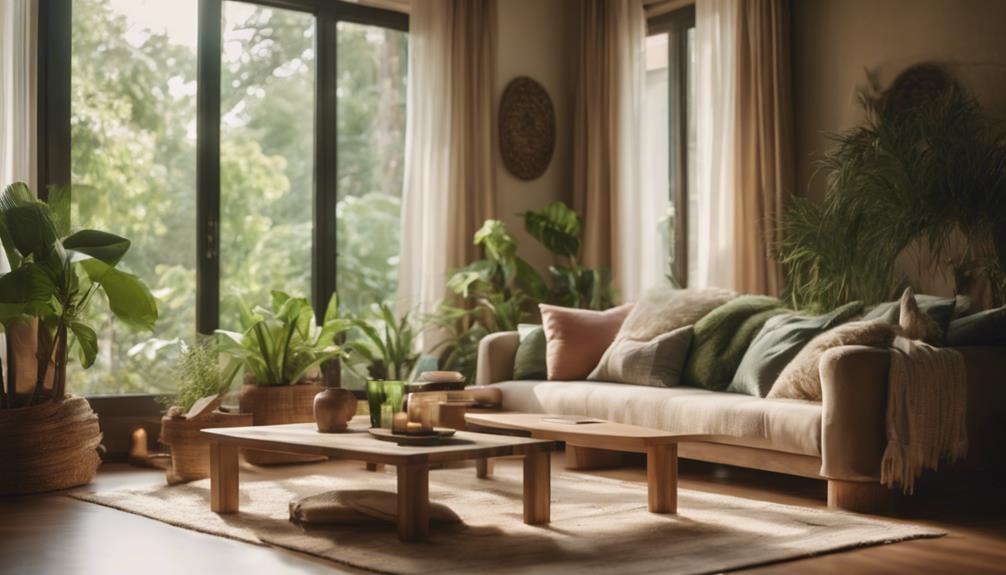
Balancing colors, textures, and materials in your decor helps create a harmonious space that feels both inviting and calming. To achieve this, focus on incorporating natural elements like wood, stone, and plants. These organic materials not only enhance tranquility but also foster a connection to nature.
Consider these aspects to evoke emotion in your space:
- Warm earthy tones that radiate comfort and coziness
- Cool colors that promote a serene and peaceful atmosphere
- Varied textures like soft fabrics and smooth surfaces for visual interest
Crafting With Natural Materials
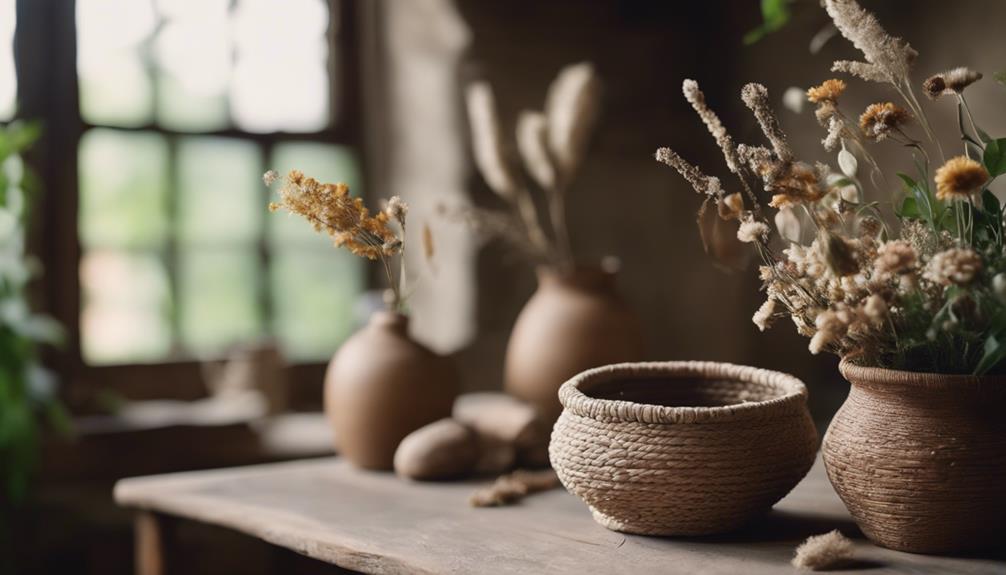
Incorporating handcrafted decor into your space not only enhances its beauty but also nurtures a deeper connection to nature through the use of sustainable materials. Crafting with natural materials like leaves, moss, and tree bark allows you to create unique, eco-friendly decor that stands out.
For instance, you can press leaves to make vibrant bookmarks or string them into decorative garlands, adding rich colors and textures to your home.
Moss is another versatile choice. You can use it to craft beautiful terrariums, centerpieces, or even moss wreaths, effortlessly bringing a touch of nature indoors with minimal upkeep.
Additionally, consider using tree bark harvested from fallen trees. It can be transformed into rustic picture frames or shelving units, infusing your living spaces with warmth and character.
Seasonal Decor Inspiration
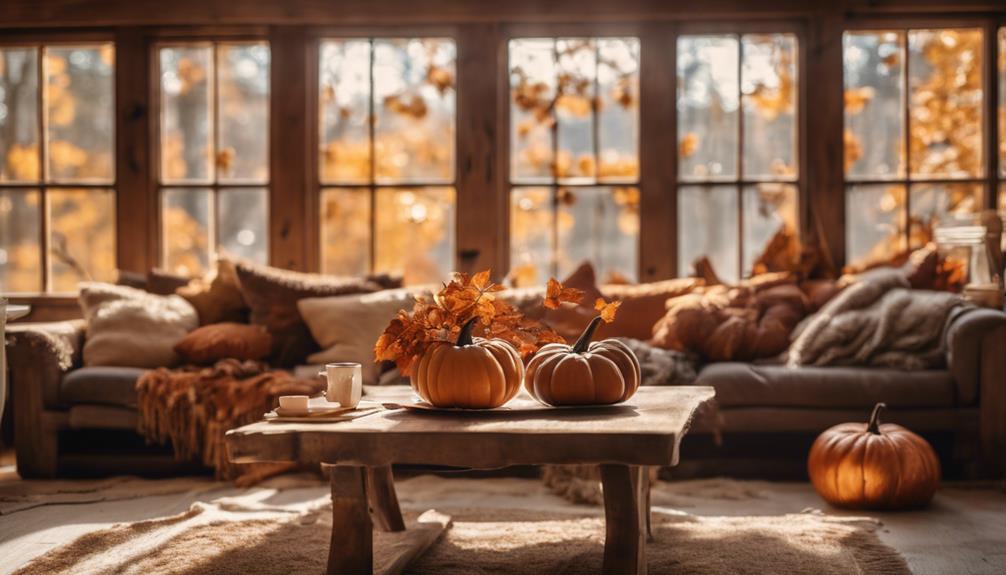
Seasonal decor inspiration draws on nature's bounty, allowing you to refresh your home with vibrant elements that reflect the changing times of the year. By incorporating seasonal natural materials, you can create a warm and inviting atmosphere that evolves with each season. This not only enhances the festive spirit but also helps you connect with nature as you embrace the beauty around you.
Consider these inspiring ideas for your seasonal decor:
- Use autumn leaves to create stunning centerpieces.
- Gather pinecones and acorns for charming winter crafts.
- Arrange spring flowers for colorful displays that brighten your space.
Rotating these decorations regularly keeps your decor dynamic and engaging. Plus, crafting with seasonal items, like making leaf prints or moss arrangements, can be a fun way to express your individuality.
By tapping into seasonal decor inspiration, you're not just beautifying your home; you're fostering a deeper connection to the environment and celebrating the rich textures and colors that nature offers throughout the year.
Embracing Sustainability in Design
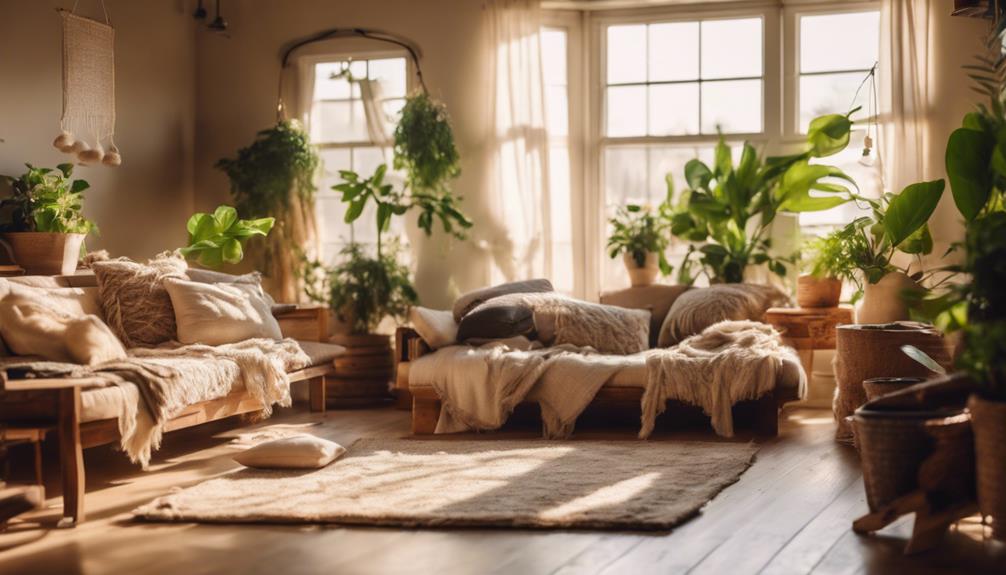
As you refresh your home with seasonal decor, consider how embracing sustainability in design can additionally enhance your living space while protecting the environment. By opting for eco-friendly materials like reclaimed wood and natural fibers, you can reduce your carbon footprint and promote conservation. Sustainable products often come with Environmental Product Declarations (EPDs), which provide transparency about their environmental impacts, helping you make informed choices.
Incorporating natural decor not only beautifies your home but also supports local ecosystems. Using non-toxic materials guarantees a safer environment for you and your family. Moreover, implementing sustainable practices like recycling and upcycling fosters creativity, allowing you to craft unique pieces while minimizing waste.
The beauty of sustainable design lies in its ability to spark conversations about our responsibility to the planet. Every time you choose eco-friendly materials or sustainable products, you encourage awareness and appreciation for the environment.
Community and Nature Connection
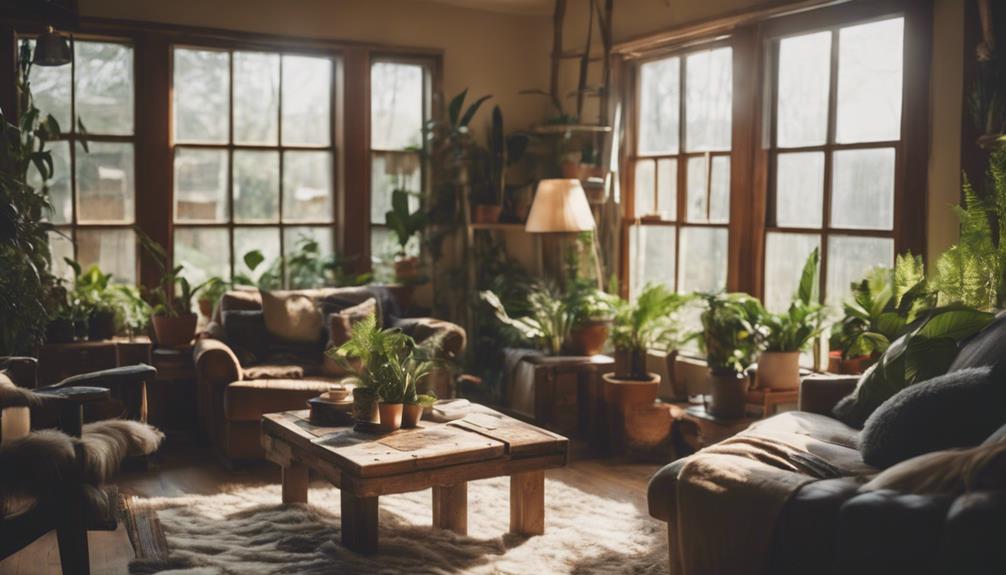
Connecting with your community through nature not only enriches your living space but also strengthens bonds and promotes sustainability. Engaging in activities like community gardens lets you cultivate plants while fostering biodiversity. You'll find that these interactions enhance your appreciation for nature and create a sense of belonging.
Consider these emotional benefits:
- Shared joy of harvesting fresh produce with neighbors
- Creative collaboration in local workshops, releasing your artistic side
- Inspiration from others through social media groups showcasing natural decor
When you actively participate in these initiatives, you're not just improving your home; you're supporting local artisans and craftspeople, which enriches your community's economy.
By incorporating handcrafted, natural elements into your decor, you celebrate unique designs that reflect your collective values. This connection to nature and community creates a ripple effect, encouraging sustainable practices that benefit everyone.
Frequently Asked Questions
What Are Home Decor Mistakes to Avoid?
Avoid overcrowding your spaces, neglecting natural light, and ignoring color harmony. Guarantee every decor item has a purpose, and don't forget to refresh your decor seasonally to keep your home feeling vibrant and inviting.
What Is Trending in 2024 Home Decor?
In 2024, you'll see biophilic design take center stage, with earthy colors, sustainable materials, and multifunctional furniture. Open-concept layouts will dominate, creating seamless connections between indoor and outdoor spaces while boosting your home's overall aesthetic.
What Are Natural Materials to Decorate?
To decorate, you can choose wood for warmth, stone for durability, and clay for creativity. Incorporate jute for texture, linen for softness, and bamboo for sustainability. Each material brings unique beauty and character to your space.
Why Use Natural Materials in Interior Design?
Using natural materials in interior design enhances warmth, promotes tranquility, and fosters a connection to nature. These elements not only improve your space's aesthetics but also boost your emotional well-being and creativity, making your environment more inviting.
Conclusion
Incorporating natural elements into your home decor can truly transform your space, making it feel more inviting and serene.
Did you know that studies show people who live in homes with plenty of natural light and greenery report a 20% increase in overall happiness?
By designing with nature in mind and embracing sustainable materials, you're not just beautifying your home; you're enhancing your well-being.
So, go ahead and bring the outdoors in—your spirit will thank you!
Home Decor
August Outdoor Furniture Trends That Will Wow You – Check Them Out!
Transform your outdoor space this August with stunning furniture trends that fuse style and sustainability—discover what awaits you!
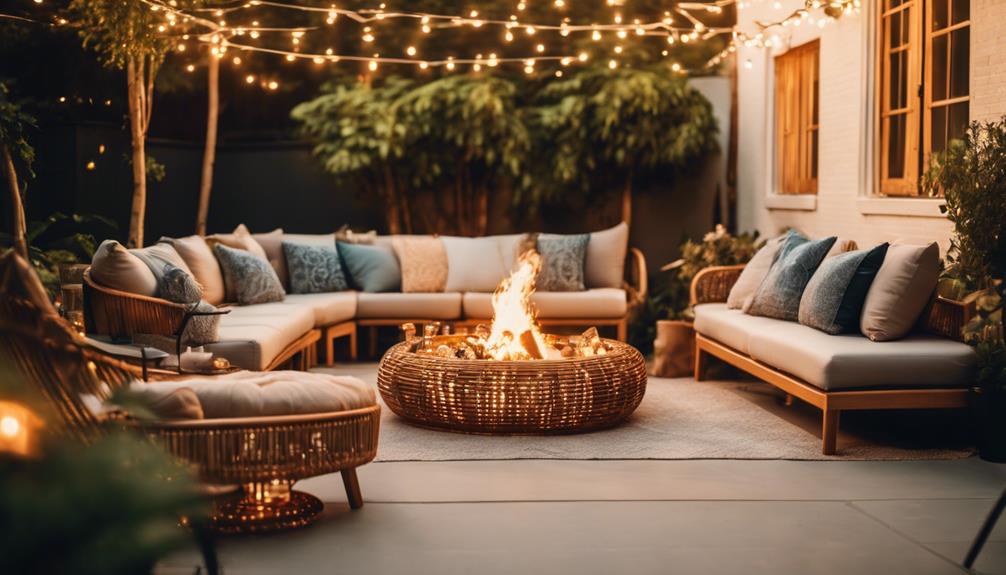
This August, you're in for a treat with outdoor furniture trends that combine style and sustainability. Look for eco-friendly options like reclaimed wood and recycled plastics, which not only reduce waste but also add charm to your space. Multifunctional designs, such as dual-purpose tables and space-saving benches, make your outdoor area flexible and inviting. Cozy textiles enhance comfort, while bold colors and organic shapes create a warm and vibrant atmosphere. Whether you prefer vintage inspiration or sleek modern styles, there's something for everyone. Discover the latest designs that will elevate your outdoor living experience. The best is yet to come!
Key Takeaways
- Eco-friendly materials like reclaimed wood and recycled plastics are trending, appealing to environmentally conscious consumers.
- Multifunctional designs, such as convertible tables and modular seating, maximize space and enhance outdoor functionality.
- Cozy textiles, including plush cushions and weather-resistant fabrics, create inviting outdoor retreats for relaxation and enjoyment.
- Clean lines and minimalist styles are popular, promoting simplicity and a clutter-free aesthetic in outdoor spaces.
Sustainable Furniture Options
When it comes to outdoor furniture, choosing sustainable options like reclaimed wood and recycled plastics can make a significant difference for both your space and the environment. By opting for sustainable outdoor furniture options, you're not just enhancing your patio; you're also contributing to a healthier planet.
Look for pieces made from responsibly sourced wood, certified by organizations like the Forest Stewardship Council (FSC). This certification guarantees that the materials come from managed forests, promoting sustainability.
Eco-friendly furniture often combines durability with style, featuring options like acacia and teak that can withstand the elements while offering long-lasting value. Investing in these materials might seem pricey initially, but their longevity makes them worthwhile.
Additionally, consider furniture crafted from recycled materials, which helps reduce landfill waste and supports a circular economy. Biodegradable materials are also on the rise, appealing to those who prioritize eco-conscious choices.
Multifunctional Designs
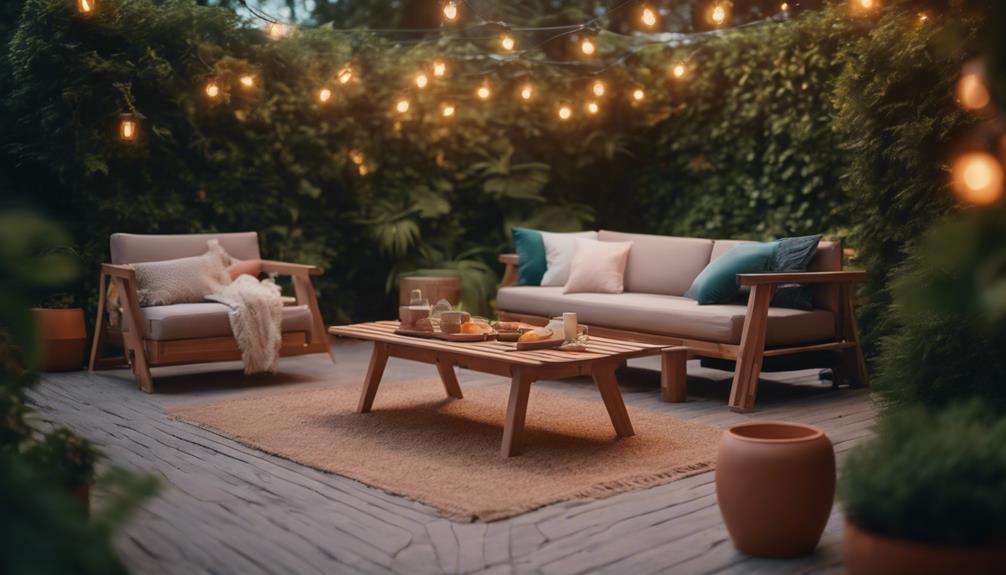
How can multifunctional outdoor furniture transform your space into a versatile haven for relaxation and entertaining?
With the rise of multifunctional designs, you can maximize your outdoor area's potential. Think of space-saving solutions like benches with built-in storage that keep your space organized while adding style.
Dual-purpose furniture, such as convertible tables, allows you to effortlessly switch from dining to lounging, making your gatherings more enjoyable.
Customizable configurations, including L-shaped and corner sofas, give you the freedom to rearrange your seating to accommodate different activities. Whether you're hosting a barbecue or enjoying a quiet evening outside, modular seating arrangements adapt to your needs.
The beauty of these multifunctional outdoor furniture pieces lies in their ability to blend style and practicality. You won't have to sacrifice aesthetic appeal for usability; instead, you can create a chic, functional space that impresses your guests and enhances your outdoor living experience.
Embrace the trend of multifunctional designs and discover how these innovative solutions can elevate your outdoor environment, making it a place where you can relax and entertain with ease.
Cozy Textiles for Comfort
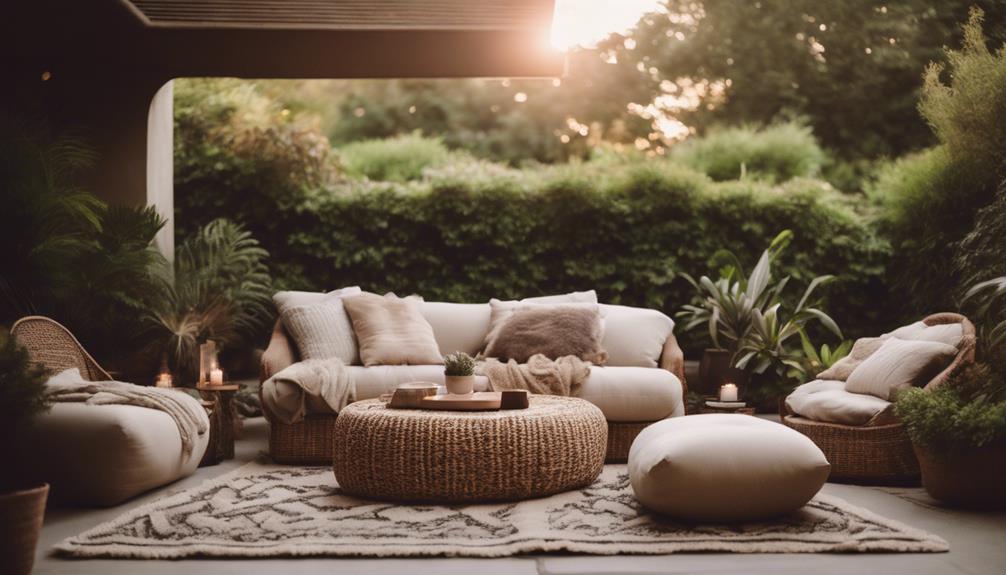
Cozy textiles transform your outdoor space into a comfortable retreat, inviting you to relax and enjoy the fresh air. By incorporating plush cushions and throws, you can enhance your outdoor furniture options to create a sanctuary that blends comfort and style. Weather-resistant fabrics are vital, as they guarantee your textiles withstand the elements while remaining inviting.
Layering textiles—like soft throws and decorative pillows—adds warmth for those cooler evenings. It also introduces a delightful mix of colors and patterns that can elevate your outdoor aesthetic. You'll find that adding these cozy textiles not only brings a sense of comfort but also encourages socializing and leisure activities with family and friends.
Easy maintenance is vital for any outdoor space, and choosing textiles that are simple to clean keeps your area looking fresh throughout different seasons. With the right cozy textiles, you can enjoy your outdoor retreat year-round, making it a perfect place to unwind.
Embrace these trends, and let your outdoor space reflect a blend of comfort and style that you'll love coming home to.
Organic and Minimalist Styles
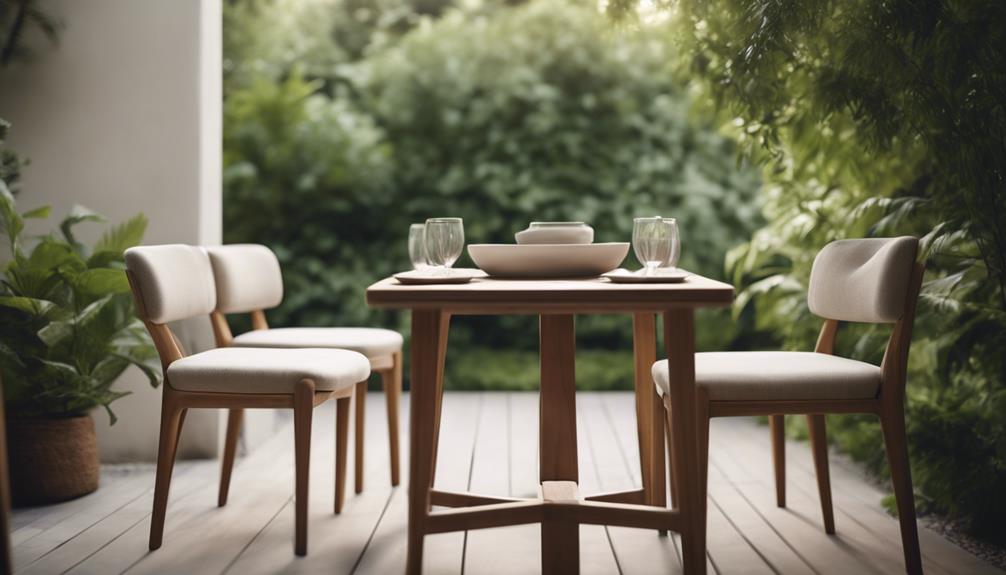
When you choose organic and minimalist styles for your outdoor space, you're embracing clean lines and a functional aesthetic that highlights natural materials.
This approach not only creates a calming environment but also enhances the beauty of your landscape.
Natural Material Emphasis
Emphasizing natural materials like responsibly sourced wood and bamboo, outdoor furniture trends are shifting towards organic and minimalist styles that enhance your outdoor spaces. You'll find that materials such as teak and bamboo aren't only durable but also environmentally friendly, making them ideal choices for your patio or garden.
Minimalist outdoor furniture is all about simplicity, allowing you to create a clutter-free environment that promotes relaxation. The designs often feature clean lines and functional elegance, making them easy to integrate into your lifestyle.
Neutral color palettes dominate this trend, offering a calming effect that seamlessly blends with the natural landscape around you. These hues help create a serene atmosphere, turning your outdoor area into a peaceful retreat.
Additionally, the focus on organic textures reflects a departure from stark modernism, inviting soft curves and subtle variations into your space. This approach encourages you to connect with nature while enjoying the comforts of modern design.
Embrace these trends to transform your outdoor spaces into inviting, sustainable, and stylish environments that resonate with your lifestyle.
Clean Lines Design
The trend of clean lines in outdoor furniture perfectly complements the focus on natural materials, offering a streamlined aesthetic that enhances both functionality and style.
You'll notice how minimalist aesthetics emphasize simplicity, allowing your outdoor space to breathe. By incorporating neutral color palettes, you create a calming environment that blends seamlessly with nature.
Here are three key elements of this trend:
- Organic Textures: These add warmth and character to your outdoor furniture, making it inviting while still maintaining a modern look.
- Versatile Designs: Clean lines enable furniture to adapt to various settings, whether it's a cozy patio or a spacious garden. This flexibility guarantees that your outdoor space remains functional and stylish.
- Modular Furniture: This innovative design allows for easy rearrangement, catering to your needs and maximizing space efficiency.
Functional Aesthetic Appeal
Functional aesthetic appeal in outdoor furniture combines organic and minimalist styles, offering a harmonious blend of beauty and practicality that enhances your outdoor experience.
By prioritizing clean lines and simple forms, minimalist designs create a sophisticated yet uncluttered aesthetic for your outdoor living spaces. When you choose pieces crafted from organic materials and neutral color palettes, you promote a calming atmosphere that seamlessly integrates your furniture with the surrounding landscape.
The focus on functionality in minimalist designs emphasizes usability without excess ornamentation, making them ideal for various outdoor settings. You'll find that these pieces not only look great but also serve a purpose, encouraging you to enjoy your outdoor decor to the fullest.
Additionally, the shift towards organic textures and shapes reflects a contemporary lifestyle that values comfort and relaxation.
Incorporating these styles into your outdoor furniture fosters a serene environment where you can unwind and connect with nature. Embracing the functional aesthetic appeal of organic and minimalist designs will elevate your outdoor spaces, making them more inviting and enjoyable for you and your guests.
Vintage and Antique Inspirations
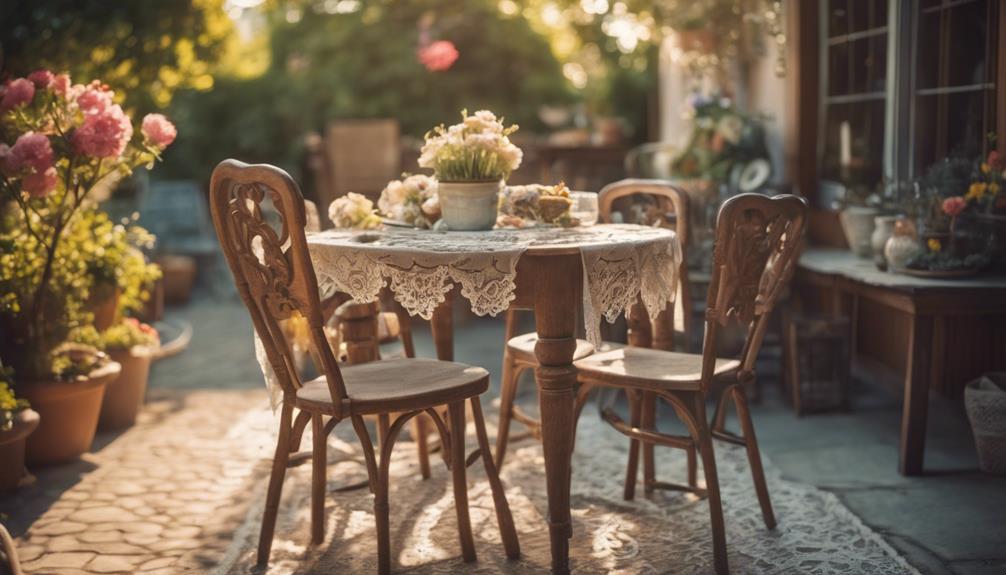
Vintage and antique-inspired outdoor furniture brings a nostalgic charm that transforms your outdoor spaces into inviting retreats. By integrating these timeless designs, you not only enhance your environment but also embrace sustainability through repurposing.
Here are three popular styles to contemplate:
- Rustic Garden Benches: These weathered pieces add a natural, lived-in aesthetic, perfect for relaxing in your garden or patio.
- Mid-Century Modern Metal Chairs: With clean lines and functional forms, these chairs provide a unique character, blending seamlessly with contemporary decor.
- Antique-Inspired Tables: Featuring intricate designs and a touch of history, these tables create a focal point for gatherings, making your outdoor space feel more inviting.
Incorporating vintage and retro flair into your outdoor furniture allows for creative expression. This approach differentiates your space from more traditional designs, fostering a cozy atmosphere that feels both stylish and welcoming.
Durable Teak and Materials
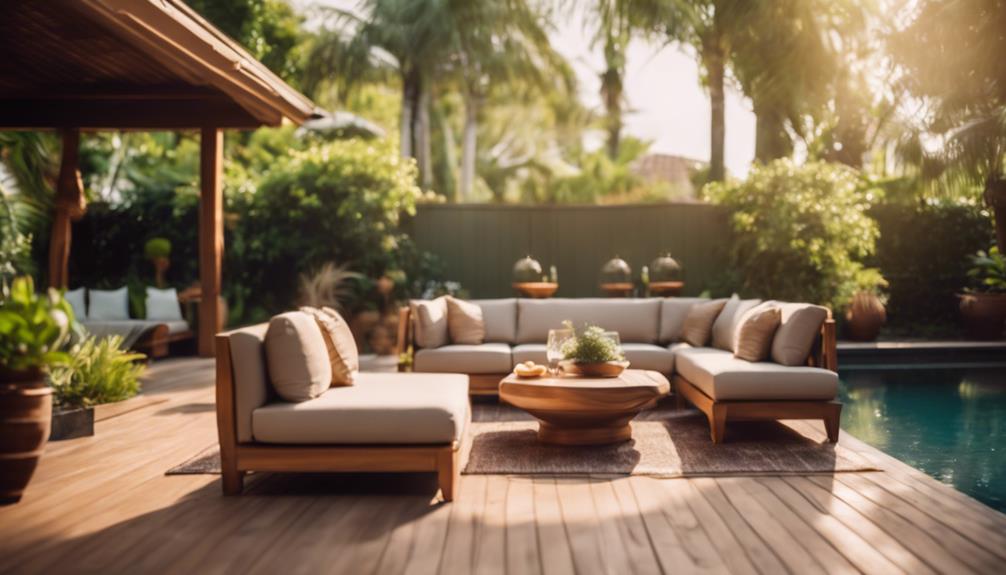
When it comes to outdoor furniture, you can't go wrong with teak wood thanks to its incredible durability and resistance to the elements.
Plus, choosing sustainable teak options supports eco-friendly practices while ensuring your furniture lasts for years.
You might also want to reflect on other durable materials like acacia, bamboo, and recycled plastics that enhance your outdoor space's resilience.
Teak Wood Advantages
Teak wood stands out for its remarkable durability, thanks to its natural oils that resist moisture, insects, and decay, making it a top choice for outdoor furniture. When you invest in teak, you're not just getting furniture; you're securing a lasting outdoor companion that thrives under various weather conditions.
Here are three standout advantages of teak wood:
- Longevity: Teak's dense structure allows it to endure harsh climates, ensuring your outdoor furniture remains intact for years.
- Low Maintenance: Unlike other materials, teak requires minimal upkeep. A simple cleaning is often all it takes to keep it looking great, allowing you more time to enjoy your outdoor space.
- Aesthetic Appeal: Over time, teak develops a beautiful silver-gray patina, enhancing its charm while maintaining its structural integrity.
Moreover, sourcing teak from sustainably managed plantations aligns with eco-conscious values, ensuring your purchase supports responsible practices.
Sustainable Material Choices
Choosing sustainable materials for outdoor furniture not only enhances your space but also supports eco-friendly practices that benefit the planet. Durable teak is a fantastic choice, known for its natural resistance to rot and stunning aging process. However, you might also consider options like reclaimed wood, bamboo, or recycled plastics, which contribute greatly to environmental sustainability.
When shopping, look for FSC-certified wood. This guarantees that the materials are responsibly sourced, appealing to your eco-conscious mindset. Investing in high-quality materials like acacia and eucalyptus not only assures long-lasting furniture but also supports sustainable forestry efforts, ultimately reducing the carbon footprint of your outdoor setup.
Moreover, biodegradable materials are gaining traction in the market, aligning perfectly with your preference for eco-friendly products. By selecting furniture made from these sustainable materials, you're not just enhancing your outdoor space; you're making a conscious choice that promotes a healthier planet.
Smart Technology Integration
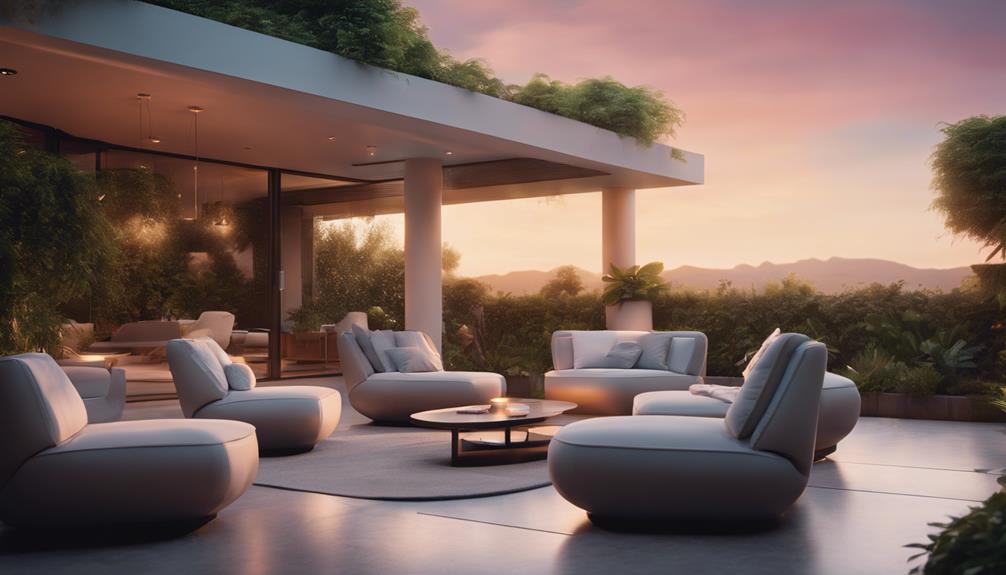
Smart outdoor furniture is revolutionizing how you enjoy your outdoor spaces with innovative features like solar-powered charging ports and Bluetooth connectivity for seamless entertainment. The integration of smart technology is a key trend in outdoor furniture, enhancing both functionality and user experience.
Here are three standout features you should consider:
- Solar-Powered Charging Ports: Enjoy your gadgets while soaking up the sun. These convenient ports let you charge your devices without worry.
- Bluetooth Connectivity: Connect your music system effortlessly. With Bluetooth, you can fill your outdoor space with your favorite tunes, making gatherings more enjoyable.
- Built-in Smart Lighting: Transform your evenings with ambient lighting. Control these features through mobile apps, setting the perfect mood for any occasion.
Moreover, many pieces integrate seamlessly with home automation systems, making it easier to manage your outdoor environment. This smart technology integration not only focuses on convenience but also enhances the overall aesthetic of your outdoor space.
Embrace these outdoor furniture trends to create an interactive and inviting atmosphere that you'll love.
Bold Colors and Patterns
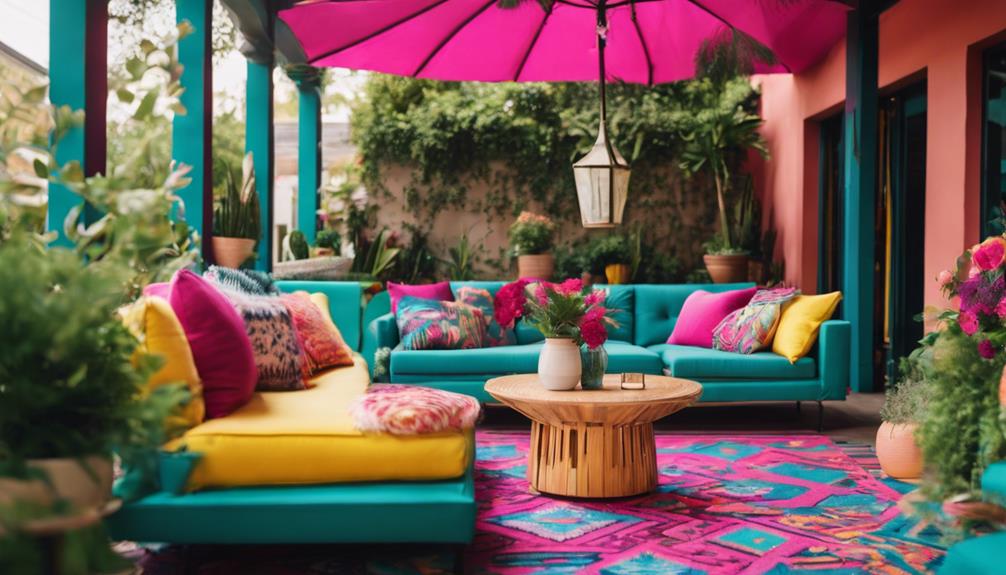
How can bold colors and patterns transform your outdoor space into an inviting retreat? By integrating vibrant colors and bold patterns, you can create a lively atmosphere that draws people in. Think deep olive green, terracotta, and burnt orange for your outdoor cushions or umbrellas. These hues not only enhance your space but also reflect contemporary design preferences.
With customization options available, you can truly express your personal style through unique combinations of colors and patterns. A mix of geometric designs and floral prints can add visual interest and excitement to patios and decks. Here's a quick overview of ideas for incorporating bold colors and patterns:
| Element | Suggestions |
|---|---|
| Outdoor Cushions | Deep olive green, burnt orange |
| Umbrellas | Floral prints, geometric designs |
| Rugs | Bright stripes, abstract patterns |
| Accent Furniture | Terracotta, lively color palettes |
Embracing these lively color palettes will not only elevate your outdoor space but also provide a welcoming retreat for family and friends. So go ahead, make your outdoor area a vibrant reflection of you!
Outdoor Living Rooms
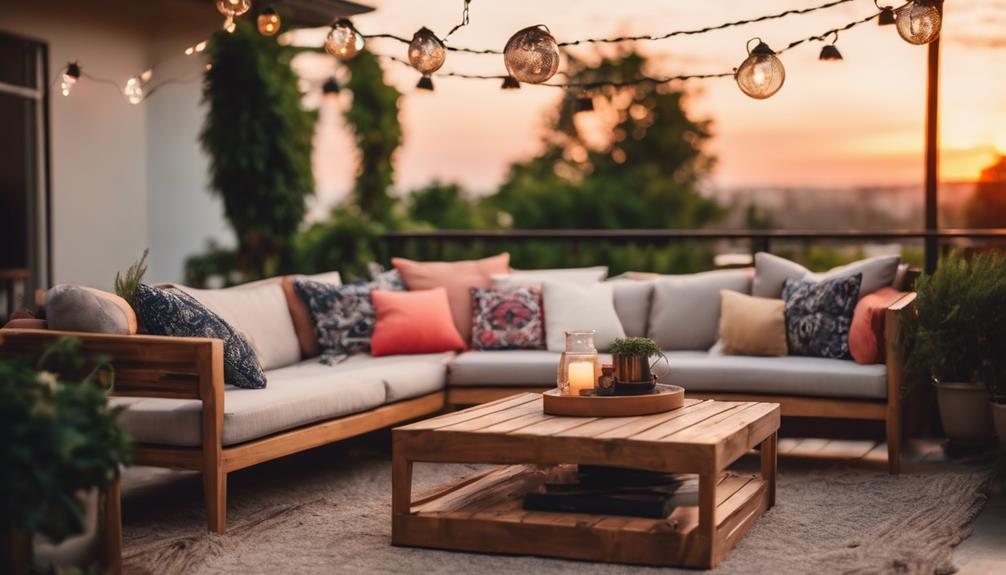
Bold colors and patterns not only enliven your outdoor space but also pave the way for creating comfortable outdoor living rooms that encourage relaxation and socialization.
These spaces can feel just as inviting as your indoor areas when you choose the right furniture and accessories.
Here are three key elements to take into account for your outdoor living room:
- Modular Furniture: Opt for sectional sofas and convertible tables that can adapt to different gatherings and activities, maximizing your space's potential.
- Comfort Features: Look for plush cushions and deep seating options that prioritize comfort, allowing you to enjoy longer evenings outdoors.
- Aesthetic Accessories: Incorporate area rugs, outdoor lighting, and decorative elements to create a cohesive style that enhances the overall experience.
Frequently Asked Questions
Is Wicker Outdoor Furniture Out of Style?
Wicker outdoor furniture isn't out of style; it's evolving. You'll find modern designs featuring vibrant colors and multifunctional pieces that fit any space, blending rustic charm with contemporary aesthetics for a timeless appeal.
How to Market Patio Furniture?
To market patio furniture, focus on eco-friendly materials, multifunctional designs, and vibrant colors. Highlight comfort features, engage on social media, and inspire customers with transformation stories to create a strong connection with your brand.
Conclusion
As you embrace these August outdoor furniture trends, you'll transform your space into a personal oasis.
By choosing sustainable options and multifunctional designs, you're not just decorating; you're crafting an experience that speaks to comfort and style.
Imagine cozy textiles wrapping you in warmth as vibrant colors dance around you.
This season, let your outdoor area reflect your personality, blending sophistication with nature.
With each piece, you're weaving a tapestry of relaxation and joy in your own backyard.
-

 Vetted2 months ago
Vetted2 months ago14 Best Personalized Father's Day Gifts for Your Husband – Show Him You Care
-

 Alfresco1 month ago
Alfresco1 month agoAlfresco Stacker Doors: Seamless Indoor-Outdoor Living!
-

 Craft and Textiles3 months ago
Craft and Textiles3 months ago15 Best Places to Buy Appliances for Your Home – Top Retailers Reviewed
-

 Decorative Throws3 months ago
Decorative Throws3 months agoIs It Better to Dry Clean Blankets?
-

 Tableware and Dining Accessories3 months ago
Tableware and Dining Accessories3 months agoWhat Is the Meaning of the Word Tableware
-

 Tableware and Dining Accessories3 months ago
Tableware and Dining Accessories3 months agoWhat Is the Hindi Meaning of Tableware
-

 Craft and Textiles3 months ago
Craft and Textiles3 months ago15 Best Cordless Mowers for Effortless Lawn Care – Top Picks of 2024
-

 Yarn3 months ago
Yarn3 months agoIs Yarn Natural or Manmade? Unravel the Truth
























